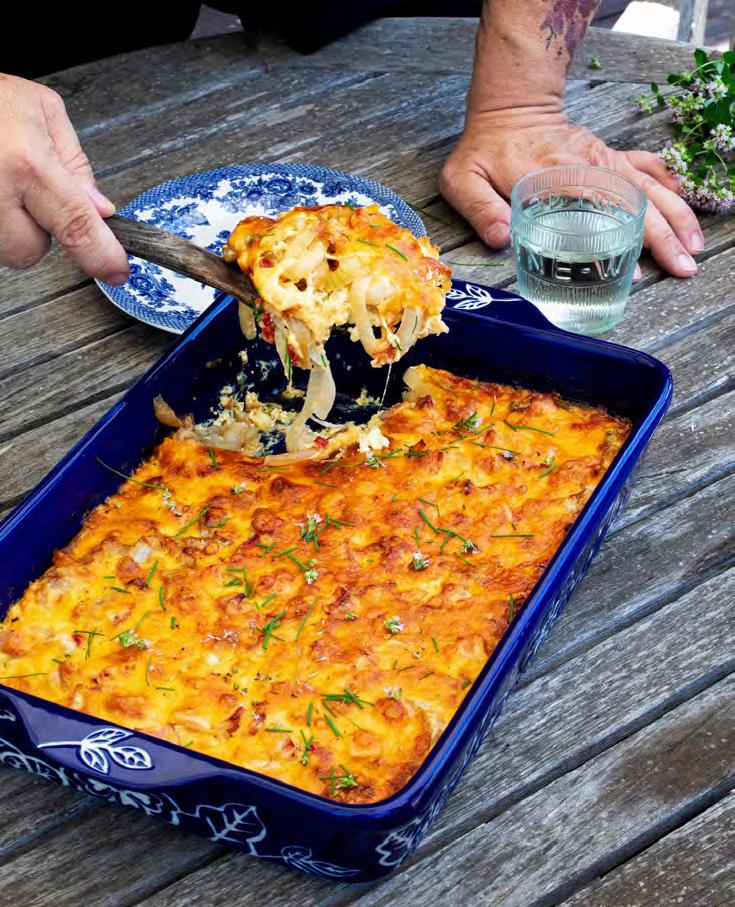
SMART FOOD ONE KITCHEN COLLABORATIVE • CLAUDETTE ZEPEDA • PARTY LIKE A KITCHENISTA SERVING SAN DIEGO COUNTY | MEMBER OF EDIBLE COMMUNITIES | EDIBLESANDIEGO.COM EAT • DRINK • SHARE • GROW NO. 71 FALL 2023 LIMITED EDITION
DIEGO
edible SAN
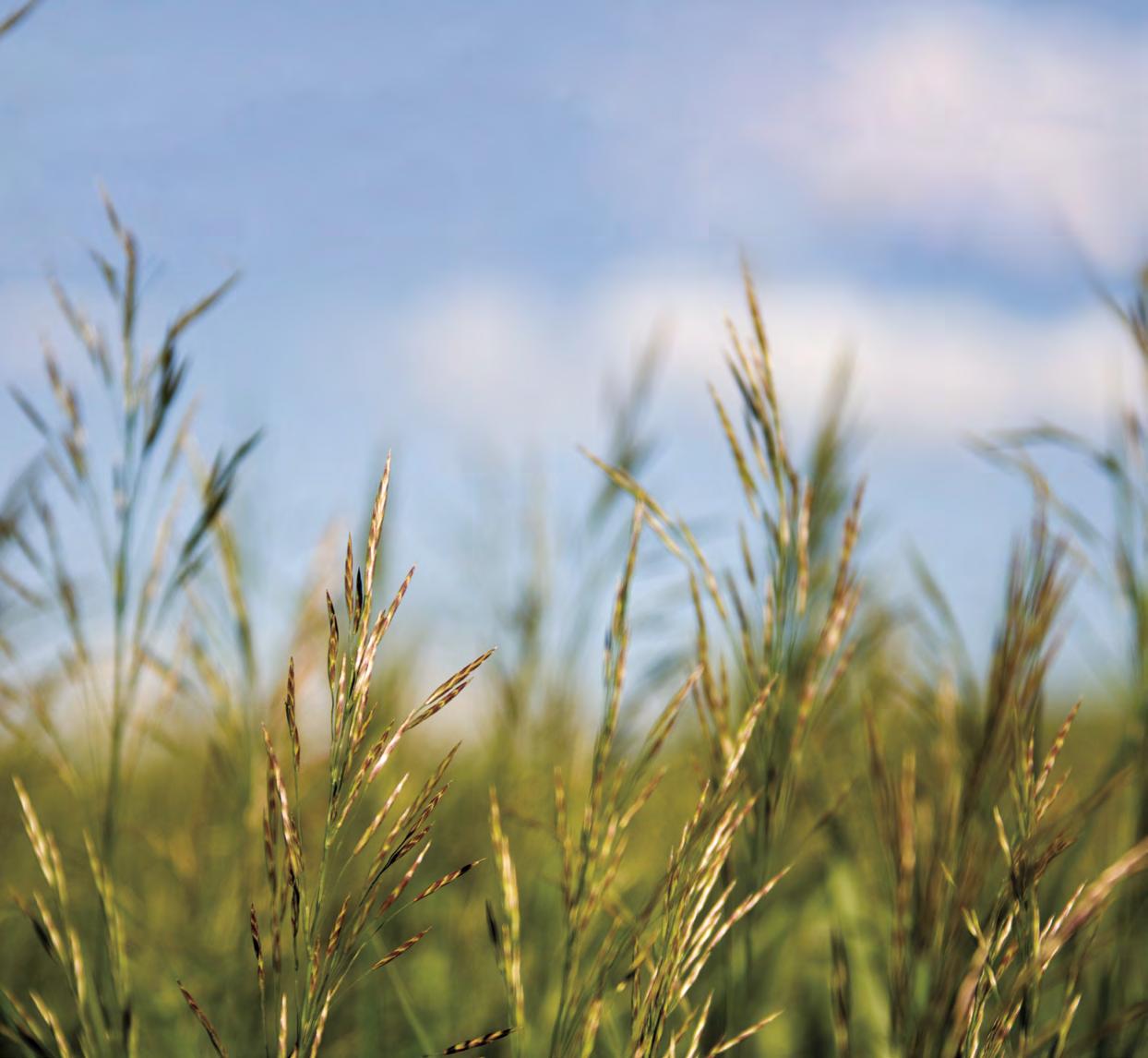
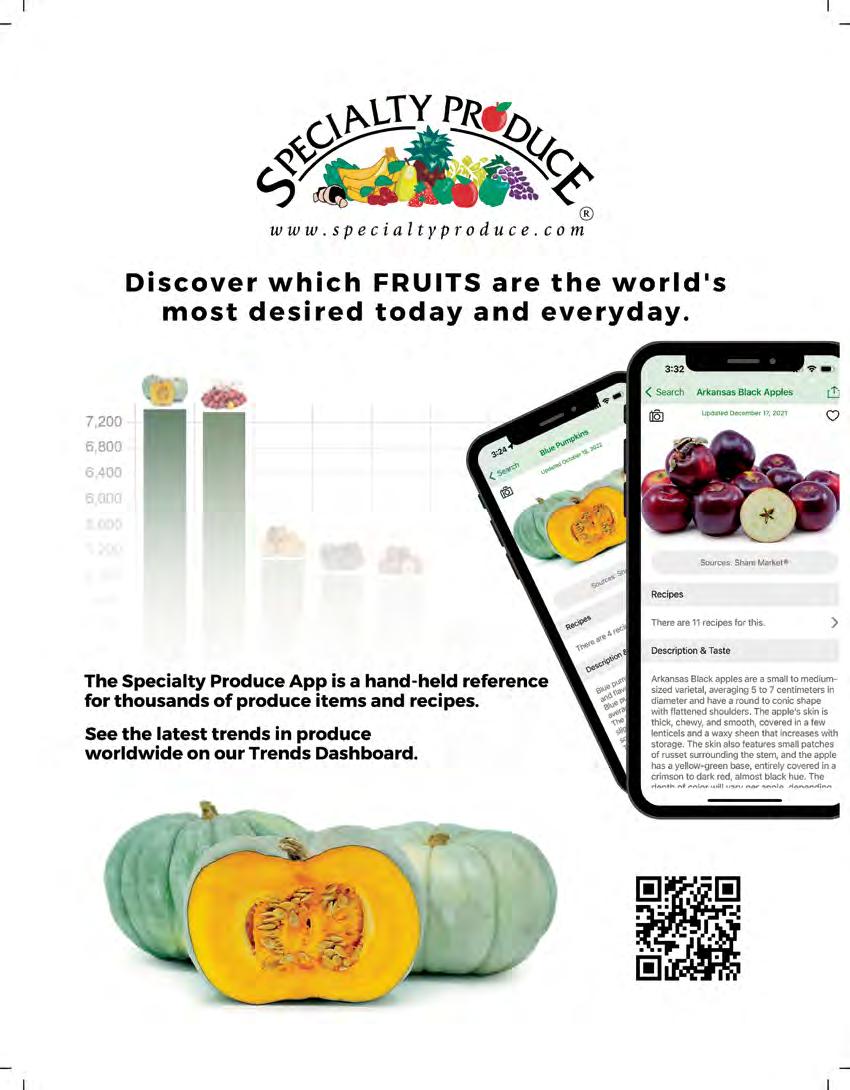







WHAT TO LOOK FOR ON EDIBLESANDIEGO.COM
• Out-of-This-World Small Farming at Ranchito Milkyway
• San Diego County Community Gardens Guide
• Innovative Crowdfunding for Food Entrepreneurs + MORE
LISTEN
• Li ving Local podcast
• Edible Communities Radio podcast available on ediblecommunities.com
WATCH @ediblesandiego ON YOUTUBE
• Barbecue-Spiced Roast Chicken with Peaches and Potatoes
• Apple and Fennel Flatbread
• Bak ed Brie with Spiced Persimmons and Pears
• Next-Level Baba Ghanoush
• How to Mak e Tom Yum Nam Khon Soup at Home
EDIBLE SAN DIEGO EXPRESS
Seasonally curated stories and recipes sent to your inbox with a digital annual membership for only $9. Benefits include discounts from local business partners and VIP invites to special events and issue launch parties.
Scan the QR code to become a member.

2 ediblesandiego.com
Issue 71 IN THIS ISSUE DEPARTMENTS 4 Publisher’s Note 6 Contributors and Masthead EAT 8 Cook the Cover 11 What’s Smart About Smart Food? 16 Market Explorer: The Golden Door Country Store 18 Local Markets Guide DRINK 21 Cideries of San Diego 24 Fall Word Play 25 Cups of Wisdom SHARE 26 Rescuing Food Never Tasted So Good 29 All Eyes on Claudette 34 Intentionally Regenerative 37 Edible for Kids™ created in partnership with Barefoot Books, Inc. GROW 42 Southeast San Diego Community Garden and UCSD Learning Hub Marks 10 Years TAKEAWAY 46 How to Throw a Party Like a Kitchenista
Fall 2023 CONTENTS
ON THE COVER
When it comes to a cover-worthy casserole, Onion Pie is a winner. Recipe on page 8.
THIS IMAGE
Chef Claudette Zepeda is ready for anything and plating up more than gorgeous dishes at VAGA. Story on page 29.
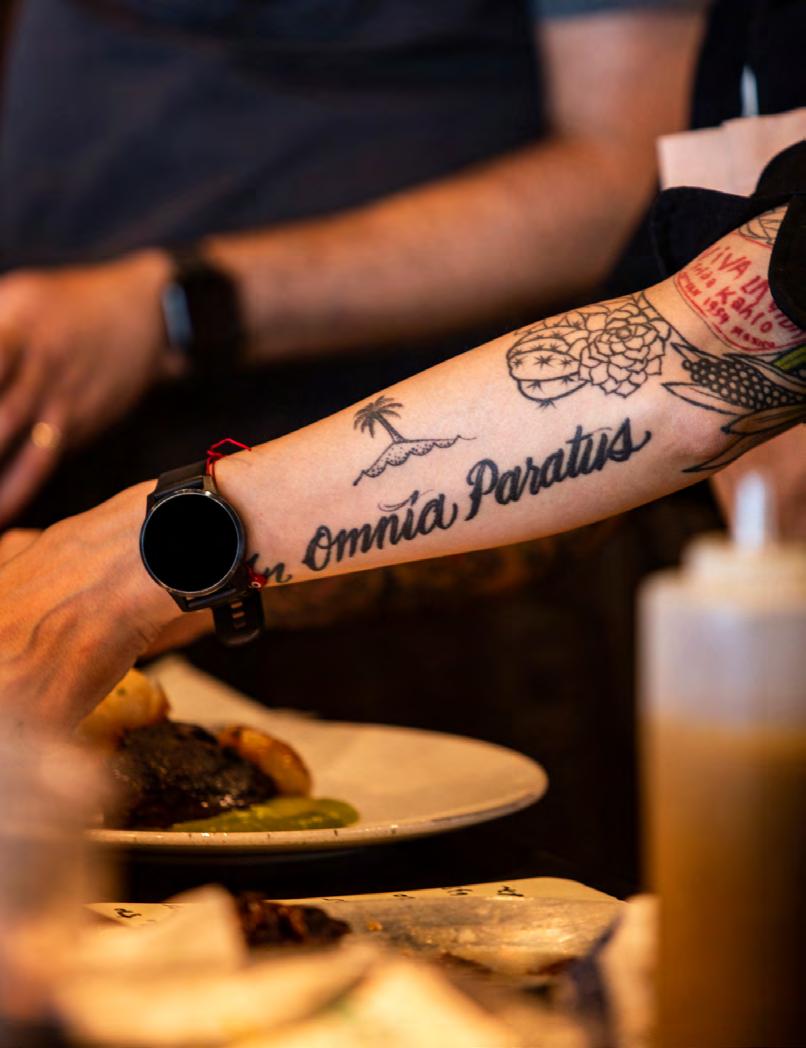 PHOTO BY LAUREN DI MATTEO FOR EDIBLE SAN DIEGO
PHOTO BY LAUREN DI MATTEO FOR EDIBLE SAN DIEGO
REGENERATIVE MEDIA

Welcome to our fall issue. We take an unexpected turn with the idea of Smart Food, dedicating this issue to the courageous human beings whose work in steamy kitchens and hot fields—cooperating and working with nature—exemplifies the smartest food. Their experiences ground us in the real world and in “a vision for joy combined with justice,” as Anna Mulè, executive director of Slow Food USA, recently put it. As we assembled this issue, Maria and I savored feedback from you—how teenagers eagerly tackle the crossword puzzle (page 24), young parents appreciate the Edible for Kids by Barefoot Books section (page 37), and readers share beloved family recipes (page 8). Have you noticed we’re creating food systems-themed issues each season about land, water, people, and the microlevel? It’s a fair question to ask why. The answer is so we can all keep learning and “expand our circle of compassion,” as Einstein encouraged. Our resolve to unapologetically promote a regenerative lifestyle only got stronger in recent years when so much keeps changing for small businesses and for each of us.

Believe me, we know it’s unusual to print or read a magazine these days, and your time and energy are valuable. What sets us apart is how these velvety pages invite attention spans to exhale and relax. In these moments, we hope the stories and recipes that local human beings carefully research, write, photograph, edit, and present have an important effect: coming together with “joy and justice” to improve the health and wellness of people and our biosphere. Just being here means you’re already part of this regenerative movement, as is every contributor, advertiser, and vendor…brought to you by the team at
We thank you for reading this magazine. Every bit of feedback helps us do better, and the many glowing ones fill our sails. If the spirit moves you, please subscribe, join our email list, and patronize our advertisers, who’d love to become a trusted part of your life.
Wishing you abundance this autumn and always,
Katie Stokes Publisher and Editor in Chief, Edible San Diego

SPRING
Howling Moon Kombucha
Millport
OB People's Market
Rincon Reservation Road Brewery
Solar Rain
Solare Ristorante
TunaVille Market & Grocery
PUBLISHER’S NOTE |
2023 ISSUE LAUNCH PARTY SPONSORS
Thank You
We're celebrating 15 years in print by bringing new seasonal issues of Edible San Diego magazine to life. You're Invited Upcoming events will be announced in the ESD e-Newsletter. Sign up and join us.
IZZIE MATTOX
OUR SALMON HOT DOGS ARE DELICIOUS, HEALTHY, AND SUSTAINABLE IN EVERY BITE!
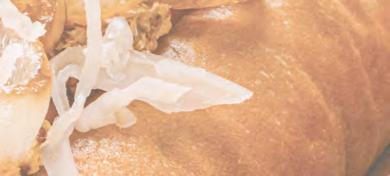




















Find Kvarøy’s salmon hot dogs in the frozen section of the fish and seafood department at Whole Foods Market. Find a store near you
supporter of
Proud
Can a HOT DOG CHANGE the World?
Mia Ballesteros is a creative photographer based in San Diego specializing in portrait, lifestyle, and event photography. She loves capturing the beauty of a moment frozen in time and aims to find inspiration in all things.
Barefoot Books is an award-winning, independent, women-owned and run children’s book publisher based in Concord, MA. Founded by two mothers in England in 1992, they are committed to creating visually captivating books that celebrate global awareness and diversity, spark curiosity, and capture imaginations.
Beth Demmon is an award-winning San Diego-based freelance writer, beer and cider judge, and author of The Beer Lover’s Guide to Cider: American Ciders for Craft Beer Fans to Explore. You can view all of her work at bethdemmon.com or on Instagram at @thedelightedbite.
Lauren di Matteo is a San Diego-based storyteller capturing the beauty of heritage and hard work, celebrating the inherent dignity of her subjects. She is drawn to stories of craftsmanship, sustainability, regenerative agriculture, and ethical sourcing, and is passionate about bringing those topics to light. Whether photographing a Michelin-starred chef or farmer in foreign fields, it’s the commitment to craft and persistence through hardship that inspires Lauren’s work.
Dr. Sabrina A. Falquier, MD, CCMS, DipABLM is a triple-board-certified physician. Born and raised in Mexico City, she is a bilingual and multicultural award-winning international educator, culinary instructor, speaker, doctor, podcast host, and CEO of Sensations Salud, which focuses on empowering through nutritional knowledge and culinary literacy by way of culinary medicine education and consulting. She is also incredibly proud to be the board chair of Olivewood Gardens. Follow @sensationssalud.
Cherie Gough is a San Diego native passionate about food equity, outdoor adventure, gardening, and education. Her daughter’s diagnosis of celiac disease prompted her to pursue food writing and share simple solutions for eating, cooking, and traveling with food allergies for Huff Post Food & Drink, Gluten-Free Forever, and San Diego Family. Find her on Instagram @cgoughwrites.
Holly Haines started developing recipes in 2013 on her blog, From My Impossibly Tiny Kitchen. Since then, she’s competed against professional chefs on national television, self-published her first cookbook,
EDITORIAL
Katie Stokes
Editor in Chief
Maria Hesse
Executive Editor
Dawn Mobley
Copy Editor
DESIGN
Maria Hesse Designer
How to Eat Your Feelings, and shared countless recipes across social media. She lives in San Diego, where you can find her measuring vanilla with her heart. Find her at itsholly.com and @itsholly on Instagram.
Haley Hazell is a San Diego-based art director, photographer, food stylist, and recipe developer. She attended culinary school at San Francisco Cooking School and now resides in San Diego with her husband and daughter. For Haley it is all about balance—balancing careers, tastes, and textures. She loves to cook and eat with the seasons, letting the amazing peak produce from her local farmers’ markets inspire her recipe writing.
Paul Hormick is a horticulturist and environmentalist with a master’s degree in environmental science and policy. As a freelance writer, his interests are in the environment, current events, music, and the arts. He is the author of As We Believe: Conversations of Religion and Faith. Paul lives in San Diego with his wife, Bryna.
Bhadri Kubendran is a visual dreamer drawing inspiration from the smallest organisms to the largest cosmic objects. When unique art and meticulous science collide on a path-breaking culinary creation anywhere in the world, you can expect to somehow find him there with his camera. He has a keen interest in the unknown and hopes to wander off into the final frontier for a journey of a lifetime.
Keith A. Lord is the owner and chief disruptor of Stratәjē Fourteen, a national culinary logistics, systems, and operations consulting firm. An award-winning chef and high-volume caterer, Keith is the one that makes you question industry standards and empowers you to optimize your business through the ceiling.
Julie Pendray has experience working in the natural resources and environmental field as well as moonlighting in the food industry and traveling for stories. She is a certified master composter, an avid gardener, and loves to learn about nutrition. She has covered California as a journalist for over four decades.
Alicia Pivirotto-Pearlman grew up eating from her parents’ garden and cooking in her family’s kitchen. She teaches cooking classes in which menus are curated based on seasonality and simplicity. She prides herself on sourcing ingredients from local farmers, fishmongers, and markets. When she’s not teaching, you can find her at The Vegetable Shop at Chino Farm, in her kitchen cooking for her family’s wellbeing, or on Instagram @aliciapivirottopearlman.
Lulu Yueming Qu is a professional artist and art teacher with the US Arts Education Center in San Diego. She moved from Beijing to New York in 2014, relocated to San Diego in 2018, and founded her LLC, LULU.LIVE ART, in 2019. She has a master’s degree in traditional Chinese painting from the Central Academy of Fine Arts in Beijing and a second master’s in illustration from the Fashion Institute of Technology in New York, granting her a unique artistic style that combines traditional Chinese painting and story-telling illustration together. You can view Lulu’s portfolio on her personal website lululiveart.com or on Instagram @qululululu.
Mike Reeske grows Rio Del Rey organic heirloom dry beans. For more information about heirloom beans and recipes, visit riodelreyfarms.com.
Ryan Rizzuto is a chef, entrepreneur, and event curator in San Diego. You can taste his work at his soul food popup, Southside Biscuits. Chef Ryan was nationally recognized as a 2020 Food Hero by Edible Communities and Niman Ranch for his Covid-19related hunger relief operations at Kitchens for Good. Follow him on Instagram at @chefryanrizzuto and his soul food and public events at @southsidebiscuits.
Deanna Sandoval is a food and lifestyle photographer based in San Diego. As a culinary graduate of the Art Institute, Deanna realizes her love for textures and colors, transitioning her culinary prowess into food photography. Her insight and knowledge of kitchens and restaurants helps her tell her version of a culinary story dear to our city through bold, vibrant, and playful visual presentation.
Lindsay Smith learned to cook from her grandmother, a self-taught home cook who whipped up elaborate holiday feasts and decadent family meals on the regular. She takes dishes loved as a child and updates them with a Southern California flare. Citrus and avocados abound in her recipes and Taco Tuesday is a way of life. Lindsay combines fresh, local, and seasonal ingredients in ways to suit every palate and that are simple enough even the most novice home cook can execute them perfectly. You can find her at lindsayeats. com.
Michelle Stansbury is an award-winning freelance writer based in San Diego. She covers travel, food, and parenting for Marie Claire, Good Housekeeping, and more. Misuse of the word “literally” drives her figuratively insane. Find her on Instagram @discoverwithmichelle.
PUBLISHER
Katie Stokes
ADVERTISING
Toni Kraft
Katie Stokes
For information about advertising options, rates, and deadlines please contact katie@ediblesandiego.com.

COVER PHOTO BY HALEY HAZELL
No part of this publication may be used without written permission from the publisher. © 2023 All rights reserved. Every effort is made to avoid errors, misspellings, and omissions. If an error comes to your attention, please let us know and accept our sincere apologies.

2017 Updated
This magazine is made possible thanks to Edible San Diego advertisers, members, and subscribers. Thank you for supporting San Diego’s local and independently womenowned food media company.
CONTACT
Edible San Diego 1501 San Elijo Rd. South #104-210 San Marcos, CA 92078 601-526-1919 info@ediblesandiego.com ediblesandiego.com
2017 Updated
6
ediblesandiego.com
edible Communities 2011 Publication of the Year
Media Icons
Social
@ediblesdmag Social Media Icons
@ediblesandiego Social Media Icons
@ediblesandiego edible SAN DIEGO ISSUE
2017 Updated
71 CONTRIBUTORS



GET HOOKED ON QUALITY San Diego’s Premium Fish Market Fresh Local Seafood and Sushi Specialties Family Owned and Operated for Over 40 Years Open Tues.–Fri., 8am–5pm and Sat.–Sun., 8am–3pm. Curbside Pickup Available Tues.–Fri. 5202 Lovelock Street, San Diego • (619) 297-9797 • catalinaop.com
COOK THE COVER
SHARING RECIPES FROM READERS BECAUSE THEY’RE HEIRLOOM FOR A REASON
HALEY HAZELL
Many of us share fond memories and special bonds with loved ones through food. Recipes document the multigenerational traditions and flavors that define our being. When we asked readers to share their favorite recipes with a chance to be featured on the cover of this issue, nearly a dozen viable submissions came in with beautiful stories attached about the families, communities, places, and events that made these recipes meaningful.
Volunteer judges reviewed the recipes and chose three to test: Chef Keith Lord picked Onion Pie, while Dr. Sabrina A. Falquier selected Lentils Sopita, and Alicia Pivirotto-Pearlman went with the Seasonal Veggie Stir-Fry with Rice Stick Noodles. All were delicious, but the Onion Pie won us over with each comforting bite. Many thanks to Jimbo’s for sponsoring the groceries, to Mary Platos of Ethos Culinary for the extra help in the kitchen, and the readers who participated in the first Cook the Cover contest. Recipe submissions have been modified for you to recreate at home. D
Onion Pie
Cover winning recipe submitted by Amy Cunningham
This dish was served at most of our family holiday or birthday gatherings at the home of my mother-in-law, Florence Cunningham, who even into her 80s served up fabulous feasts. I always think of her and good times when I make it, and it always gets surprised raves. It’s a little like a quiche in a casserole dish— very simple and elegant.
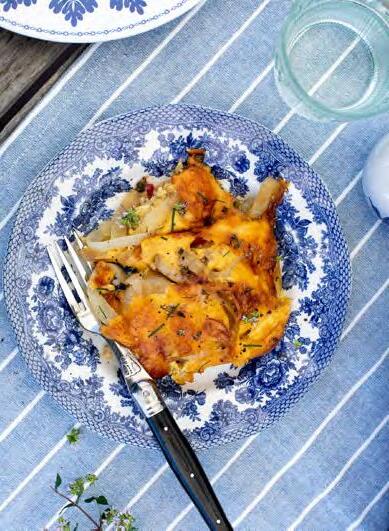
SERVES 6–8
2 sleeves soda crackers
3 Vidalia sweet onions, sliced
1 stick butter
2 cups whole milk
5 large eggs
Salt and pepper to taste
2 cups grated cheddar cheese
Preheat oven to 350°. Line a 9x11-inch pan with two layers of soda crackers. Sauté onions in butter until tender, then spread over the crackers. Beat milk, eggs, and seasonings together and pour over the onions. Sprinkle grated cheese over the top and bake for 35 minutes. Let stand 15 minutes before cutting. Serve warm or at room temperature.
(Optional add-ins before covering with cheese: diced Canadian bacon, sliced mushrooms, chopped broccoli, diced bell peppers, zucchini, parsley, or pimento. This dish is endlessly versatile!)
Recipe as tested by Keith Lord
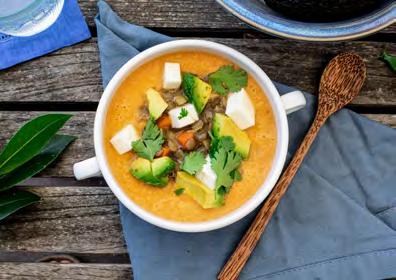
EAT |
RECIPES SELECTED AND TESTED BY KEITH LORD • DR. SABRINA A. FALQUIER • ALICIA PIVIROTTO-PEARLMAN STYLING AND PHOTOGRAPHY BY
Lentils Sopita
Lentils Sopita
Submitted by Angelica Gastelum
I have a family tradition of making Lentils Sopita that I started with my children. It’s a recipe passed down from my grandmother, and the term sopita is used to describe something small but valuable. My grandmother, Rafaela Alvarez, used to make sopita de lentejas to show us her love and affection. My spin was to add vegetables to make it more nutritious!
SERVES 6–8
2 cups green lentils
6 cups water (ratio of lentils to water 1:3)
2 bay leaves
1–3 tablespoons olive oil
1 large carrot, washed, scrubbed, and diced (about 1 ½ cups)
2 ribs celery, diced (about 1 ½ cups)
2 medium onions, chopped (about 3 cups)
2–3 medium tomatoes, chopped (about 3 cups)
2 cloves garlic, minced
2 tablespoons ground cumin, plus more to taste
2 tablespoons nutritional yeast, plus more to taste
1 teaspoon salt, plus more to taste
1 teaspoon black pepper
Cubed avocado, queso fresco, or bacon to garnish
To prepare lentils, first wash them thoroughly. Add them to a large stockpot with water and bring to a boil, then reduce heat to simmer. Add bay leaves and let it simmer until lentils are cooked through, about 25 to 30 minutes.
Meanwhile, add olive oil to a large sauté pan and sauté carrots and celery for 5 minutes; add the celery and carrots to the simmering lentils.
In the same sauté pan, on medium-low heat, sauté onions, tomatoes, and garlic until soft, 5 to 10 minutes. In a blender, purée the sautéed vegetables to create a smooth texture and add to the simmering lentils. Season with cumin, nutritional yeast, salt, and pepper; stir and adjust to your liking. For a garnish, my kids enjoy avocado, queso fresco, or bacon.
Recipe as tested by Dr. Sabrina A. Falquier
Seasonal Veggie Stir-Fry with Rice Stick Noodles
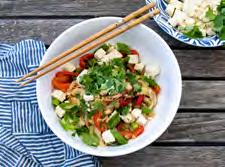 Submitted by Thi Vo
Submitted by Thi Vo
Cook the noodles according to the package instructions.
While the noodles are cooking, wash and chop the veggies, and soak bean sprouts in cool water for five minutes. The cooking process goes fast, so having everything chopped and ready to go is important. Make the garlic oil: To a large-sized cold pan or wok, add olive oil and chopped garlic and turn the heat to medium-high. Cook the garlic until near golden (about 3 to 5 minutes) and remove from heat. The residual heat will keep cooking the garlic to a deeper golden color. Transfer oil along with garlic to a bowl, and set aside to use the garlic oil through the cooking process.
This dish is a crowd-pleaser that my mom, Mai Tran, makes year-round. The recipe is a staple in my family because we are able to switch out our proteins and veggies depending on the season and the audience we’re serving. Vegetable ratios can be adjusted based on taste! Feel free to swap out any vegetables you don’t like.
SERVES 5–7
1 packet rice stick noodles*
¼ cup extra-virgin olive oil
4–6 medium cloves garlic, diced 7 ounces tofu** (half a package), ¼-inch dice
3 bell peppers, thinly sliced
1 small or ½ medium cabbage, thinly sliced
1 shallot (or 3 green onions), thinly sliced
1 cup bean sprouts
1 teaspoon sesame oil
3 tablespoons vegetarian mushroom oyster sauce
1 tablespoon plus 1 teaspoon soy sauce, or more to taste
2 tablespoons sugar (optional)
Salt and pepper to taste
½ bunch garlic chives, chopped to 1-inch pieces
1 small bunch choy sum, chopped to 1-inch pieces
*Find rice stick noodles at any Asian store or online, or substitute with glass noodles, fresh rice noodles, Pad Thai rice noodles, or even angel hair pasta.
**My family gets pre-fried tofu at our local Viet supermarket/deli. Or substitute with your choice of protein. My mom uses shrimp when making it for a party.
Fry the tofu: Add 1–2 tablespoons of the garlic oil back to the pan and set to medium-high or high heat, add diced tofu, and stir-fry until the tofu turns golden (approximately 5 minutes). Add more olive oil if needed. Remove from the pan and set aside.
Stir-fry the veggies: Add 1–2 tablespoons of garlic oil to pan on high heat. Add bell peppers, cabbage, shallots, and bean sprouts, or other hearty vegetables you may be using. This is your chance to season to your taste. Add the sesame oil, 2 tablespoons of vegetarian oyster sauce, 1 tablespoon of soy sauce, sugar, salt, and pepper. After tossing the veggies with the sauces and seasonings, allow the vegetables to cook on high heat for 5 to 7 minutes before adding in garlic chives and leafy parts of the choy sum. Cook until the veggies are to your liking—for crunchier veggies, stop cooking sooner. Remove veggies from wok or pan and transfer to bowl.
Stir-fry noodles: Add the remaining garlic oil and garlic bits into the pan on medium-high heat and add the drained rice stick noodles. Add more olive oil if needed. Stir-fry the noodles until the noodles are no longer soggy from the soak, 5 to 6 minutes. Season the noodles with 1 teaspoon soy sauce, 1 tablespoon vegetarian mushroom oyster sauce, and salt and pepper to taste. Toss. Add all the veggies back in and toss again. Remove from heat as soon as it’s all well combined as over-tossing can make the noodles turn mushy. Add the tofu and stir gently to avoid smashing it. Taste and adjust seasonings to your liking. Enjoy.
Recipe as tested by Alicia PivirottoPearlman
FALL 2023 | edible SAN DIEGO 9






















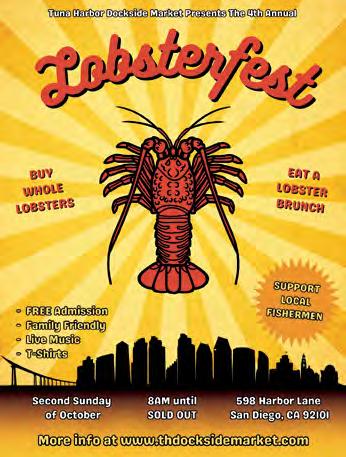

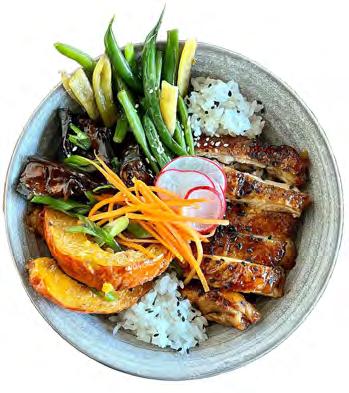



Discover Fallbrook days 9:00-1:30 pm Downtown Main Avenue between Hawthorne & Fig www.fallbrookchamberofcommerce.org WITH INGREDIENTS FROM LOCAL FARMS. LUCKYBOLT.COM FOOD THAT YOU’RE PROUD TO EAT Use this QR code to automatically apply a 10% discount to the first order you place. FARM-TO-TABLE MEAL PREP + PROVISIONS FOR PEOPLE WITH DISCERNING TASTE.
WHAT’S SMART ABOUT SMART FOOD?
HERE’S WHY BEANS ARE GENIUS
BY MIKE REESKE • RECIPE BY HOLLY HAINES • PHOTOGRAPHY BY LAUREN DI MATTEO
Three-quarters of the world’s food comes from 12 plants and five animals. Three of these plants (rice, wheat, and maize) make up nearly 60% of all plant-based calories humans consume. Of the earth’s estimated 400,000 plant species, we could eat around 300,000. And yet, we only eat 200.
This narrow range of eating habits is having a negative impact: Not only are we limiting our vitamin and mineral intake, but overreliance on a few species leaves us prone to disaster with harvests vulnerable to pests, diseases, and climate change. But there are foods that are nutritious, sustainably produced, and farmed in responsible ways that enrich the soil.
Let’s rethink what we consider smart foods to be. As the title of this issue, smart food is a term used to describe food that is healthy, sustainable for the environment, and good for those who produce it—especially the small farmer. Using this definition, beans are truly a smart food to consider.
Smart for the planet
Beans are produced and harvested in a way that does not degrade the environment’s ability to create that food in the future. Given that beans in many parts of the world typically constitute 70% of a meal and are often eaten three times a day, diversifying them can have a pronounced impact on overcoming malnutrition and poverty and coping with climate change and environmental degradation. Beans increase food security for those with shortages and can help tackle the increase of lifestyle diseases such as diabetes and obesity.

Smart for the farmer
Tepary beans survive in high temperatures. They survive with very little water and are often described as the last crop standing in times of drought.
Legumes (including beans) have long been recognized and valued
FALL 2023 | edible SAN DIEGO 11 | EAT
FLEXITARIAN COOKING
as soil-building crops. Growing legumes improves soil quality through their beneficial effects on biological, chemical, and physical conditions.

Legumes make an important contribution to soil nutrition by enhancing the nitrogen-supplying power of soils and increasing the soil reserves of organic matter.
Smart for you
Beans are safe, healthy, and nutritious, and an excellent nonfat source of protein. Just one cup of beans provides up to 16 grams of protein. Tepary beans offer the most protein of any bean. One cup provides between 21–27% of the USDA-recommended daily allowance of protein.
Beans are high in minerals and fiber without the saturated fat found in some animal proteins. They may aid in weight loss due to their high protein and fiber content, which can keep you feeling full for longer. Beans may help reduce your risk of heart disease by lowering LDL (bad) cholesterol, blood pressure, and inflammation.
Studies show that beans can aid people with type 2 diabetes. Their high fiber content gives them a low ranking on the glycemic index. In one study, blood sugar, insulin, and triglyceride levels all decreased significantly when people with diabetes ate beans instead of red meat. What’s more, beans are very affordable compared to most other nutritious, whole foods.
On a global scale, smart food speaks to some of the largest issues facing the world today:
• poor diets that contribute to dietar y-related health issues from malnutrition to obesity
• environmental issues like climate change, water scarcity, and soil degradation
• rural poverty
Beans demonstrate that the smartest foods are low-tech to their core. D
» riodelreyfarms.com
Left: Holly Haines garnishes a Three Sisters Salad with flower petals.
Three Sisters Salad
Known as the Three Sisters, beans, corn, and squash are the foundation of Indigenous American agriculture and cuisine. They grow well together, like sisters, in a garden and offer a perfect balance of nutritional benefits as the base of many Indigenous recipes. This version of a Three Sisters Salad created by Holly Haines features black and white tepary beans.
SERVES 4–8
1 cup tepary beans, soaked overnight
2 tablespoons Dijon mustard
3 tablespoons lime juice
1 tablespoon honey
6 tablespoons extra-virgin olive oil
1 jalapeño, seeded, stemmed, and minced
Kosher salt to taste
8 ounces cherry tomatoes
3 ears corn
1 pound summer squash (zucchini, pattypan, yellow crookneck, starburst)
¼ cup roasted pepitas
Torn mint and cilantro leaves, for serving
Cook the beans:
Place tepary beans in a large bowl with enough water to cover by a few inches. Soak overnight at room temperature.
Drain the beans, discard the liquid, and add the beans to a large pot with enough water to cover by a few inches. Bring to a boil over high heat, then reduce to a simmer and cook, stirring occasionally, until the beans are tender, 1 ½ to 2 hours. Drain the beans and set aside.
While the beans are cooking, prepare the vegetables and make the dressing.
Make the dressing:
In a medium bowl, whisk together mustard, lime juice, and honey. Slowly whisk in olive oil until emulsified. Stir in jalapeño. Season with salt to taste.
Marinate tomatoes:
Cut smaller tomatoes in half and quarter larger ones. Sprinkle with about ¼ teaspoon kosher salt and toss with 2 tablespoons of the dressing. Set aside.
Char the corn:
Heat a large cast-iron skillet over medium-high heat. Once hot, place corn in the skillet and let cook, without moving, until charred in spots, about 3 minutes. Turn and repeat on all sides. Remove corn from skillet, allow to cool, then cut the kernels away from the cob with a sharp knife.
Cut the squash:

Using a knife or a mandoline, slice longer pieces of squash lengthwise into thin ribbons. Slice smaller, round squash into thin coins.
Assemble:
Layer half of the beans with ribbons of squash on a serving platter. Spoon marinated tomatoes over the top, followed by the corn and the remaining beans. Drizzle with the remaining dressing and garnish with pepitas and torn herbs.
FALL 2023 | edible SAN DIEGO 13
| EAT




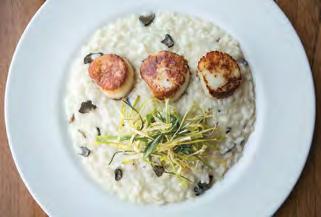

14 ediblesandiego.com Your destination for local produce, unique food and events. 314 DEER SPRINGS ROAD, SAN MARCOS Check out this week’s harvest! Award-winning Italian Cuisine, Chef, Service, and Wine List Michelin Guide Bib Gourmand Restaurant Open 7 days a week in Liberty Station for Indoor & Heated Patio Dining and Take-Out/Delivery 2820 Roosevelt Rd, San Diego | 619-270-9670 | solarelounge.com RISTORANTE ITALIANO BAR LOUNGE










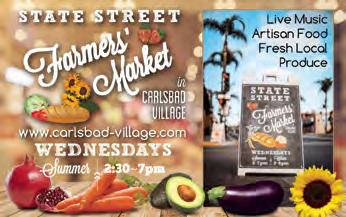
FALL 2023 | edible SAN DIEGO 15 OBPeople's FoodCo-op San Diego's only community-owned organic grocery store, since 1971! 4765 Voltaire Street San Diego, CA 92107 (619) 224-1387 www.obpeoplesfood.coop @obpeoplesfoodcoop OPEN DAILY 8am-9pm Saturdays 9:30 am – 1:30 pm 7960 CIVITA BLVD San Diego, CA 92108
SHOPPING AT THE GOLDEN DOOR COUNTRY STORE
BY MICHELLE STANSBURY • PHOTOGRAPHY BY BHADRI KUBENDRAN
Cooking mouthwatering meals at home typically starts with really, really good ingredients. The Golden Door Country Store in San Marcos is dedicated to making that easier by bringing together produce from local farms—including their own 600 acres— with other responsibly sourced groceries such as hummus, crackers, pasta, and sauces.
The Golden Door isn’t a commercial farm—rather it’s a resort. Founded by Deborah Szekely, progenitor of the modern wellness resort and spa movement, it has been named one of the world’s best destination health spas. Executive chef Greg Frey Jr. oversees garden production with a culinary eye to feed resort guests healthy meals. Frey is also the resident beekeeper, passionately tending to six hives of honeybees.
About half of the items sold at the idyllic open-air store are harvested on the property, including fruit from the orchards, herbs and vegetables from the garden, honey from the mountaintop beehives, and olive oil pressed from the olives that grow in a lakeside grove of Manzanillo trees. Nearby farms help fill in additional goods, like eggs from Ramona and artichokes from Beckstead Farms. The Golden Door kitchen also prepares packaged food products available for sale at the store, including their famed potassium broth, granola, and cookies.
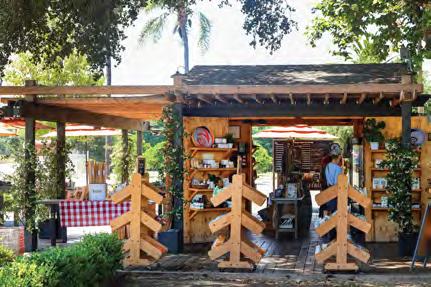
The Golden Door Country Store ties the resort to the community, creating a place where the public can shop farm-fresh produce at surprisingly reasonable prices. In addition, 100% of the store’s net profits are donated to children’s charities and philanthropies, so the shop is operated more like a community organization, and the prices at the country store are intentionally set to be competitive and offer affordable groceries to surrounding families. When the cost of a carton of eggs skyrocketed to Fabergé prices earlier this year due to bird flu-related egg shortages, Golden Door Country Store was able to keep its egg prices stable.
Before the store opened in September 2021, Golden Door started as a farm stand when they began harvesting more oranges and avocados than they needed for their guests. Then, when the resort was closed during the Covid-19 pandemic, the farm stand expanded in order to share the produce with the community.
Much of the Golden Door produce is picked immediately before the store opens, making it some of the least-traveled food you can buy in San Diego County. The chef’s garden yields quite a large variety of fruits and vegetables: dozens of types of tomatoes, avocados, citruses, squashes, and lettuces, with lesser-seen heirloom varietals holding court. Produce rotates seasonally, of course, and this summer and fall corn returns for the second year in a row now that marketgoers have become addicted to the vast difference in taste and texture of just-picked corn.
The farm employs biodynamic and biointensive growing methods along with a deep appreciation for the land to grow food sustainably. Golden Door recently purchased an additional 1,988 acres of neighboring land in North County to preserve and protect for future generations and has made climate action a priority across the business.
Store events like makers’ markets introduce shoppers to the goods of local artisans beyond the tasteful selection of merchandise usually sold in the shop. Yoga and classes on topics such as bokashi and home composting hosted on the back deck help make Golden Door Country Store a gathering place for the community. Chef Frey hosts free cooking classes, where he shares his techniques for making nutritious and delicious food. Frey’s focus on preserving lends well to the farm-to-kitchen approach of the resort and market, and teaching allows him to pass his deep understanding of the produce on to others. D
»
countrystore.goldendoor.com
16 ediblesandiego.com MARKET EXPLORER EAT |

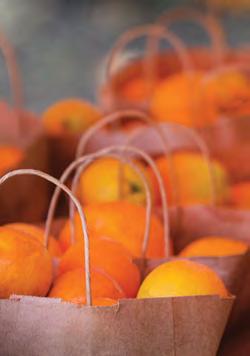

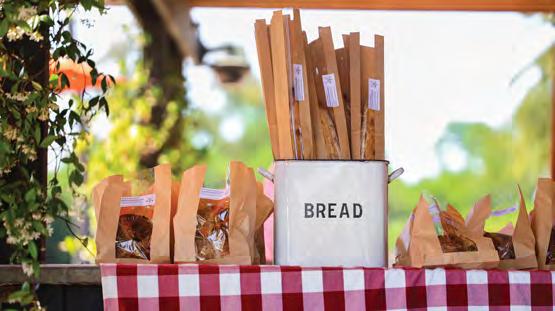
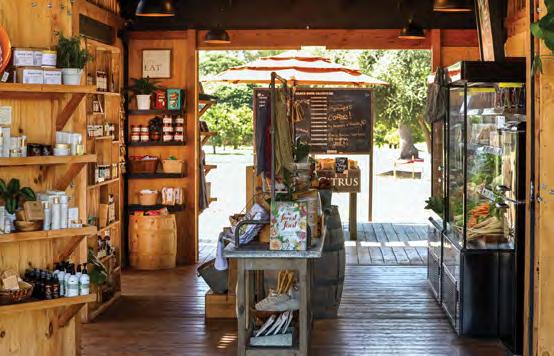

















Rancho Bernardo √ 13330 Paseo del Verano Norte Friday, 9am–1pm Escondido √* 262 E. Grand Ave. Tuesday, 2:30–sunset State Street in Carlsbad Village √ State St. & Carlsbad Village Dr. Wednesday, 3–7pm Del Mar 1050 Camino Del Mar Saturday, 1–4pm Escondido—Welk Resort √† 8860 Lawrence Welk Dr. Monday, 3–7pm Regional farmers’ and fishermen’s market listings for San Diego County. Solana Beach √† 410 S. Cedros Ave. Sunday, noon–4pm Rancho Santa Fe—Del Rayo Village √ 16079 San Dieguito Rd. Sunday, 9:30am–2pm Leucadia √* 185 Union St. & Vulcan St. Sunday, 10am–2pm Vista √*† 325 S. Melrose Dr. Saturday, 8am–noon Rancho Penasquitos 9400 Fairgrove Ln. Saturday, 9am–1pm Poway √* 14134 Midland Rd. Saturday, 8am–1pm Fallbrook Main Street √ Main Ave. btwn Hawthorne and Fig. Saturday, 9am–1pm San Marcos √ 251 North City Dr. Tuesday, 3–7pm Mira Mesa √* 10510 Reagan Rd. Tuesday, 2:30–7pm Scripps Ranch √ 10045 Carroll Canyon Rd. Thursday, 3–7pm Oceanside Morning √* 401 Pier View Way & Hwy. 101 Thursday, 9am–1pm Borrego Springs √ 700 Palm Canyon Dr. Friday, 7am–noon (Nov–Apr) Cardiff √ NEW Miracosta College San Elijo Campus 3333 Manchester Ave. Saturday, 10am–2pm ILLUSTRATED BY LULU YUEMING
edible
Santa Ysabel √ 21887 Washington St. Sunday, noon–4pm
QU
SAN DIEGO













Linda Vista √*† 6939 Linda Vista Rd. Thursday, 2–7pm Chula Vista √* 300 Park Way & Third Ave. Sunday, 10am–2pm LEGEND * M arket vendors accept WIC (Women, Infants, Children) Farmers’ Market checks. † M arket vendors accept EBT (Electronic Benefit Transfer). ! M arket vendors accept WIC Fruit and Vegetable checks. √ M arkets certified by the San Diego County Agricultural Commissioner, ensuring that the produce is grown by the seller or another certified farmer in California, and meets all state quality standards. Locations are not exact. All listings are subject to change. Please contact markets directly to confirm hours of operation and locations. Visit ediblesandiego.com for more complete information and links to market websites. Imperial Beach √*† 10 Evergreen Ave. Friday, 2–7pm (2–6pm winter) SunCoast Market 1075 8th St. 3rd Saturday, 8am–2pm People’s Produce Mobile Farmers’ Market—ECC Campus NEW 3434 Ocean View Blvd. Thursday, 9–11am La Jolla Open Aire √ 7335 Girard Ave. & Genter Sunday, 9am–1pm Hillcrest √* 3960 Normal St. Sunday, 9am–2pm La Mesa Village √* La Mesa Blvd. btwn Palm & 4th St. Friday, 3–7pm People’s Produce Mobile Farmers’ Market—Four Corners of Life NEW Imperial Ave. & Euclid Ave. Friday, noon–2pm Little Italy Mercato √*† 501 W. Date St. Wednesday, 9:30am–1:30pm Saturday, 8am–2pm Ocean Beach √ 4900 block of Newport Ave. Wednesday, 4–8pm People’s Produce Mobile Farmers’ Market—Mt. Hope 4269 Market St. Wednesday, 11am–1pm Santee *† Carlton Hills Blvd. & Mast Blvd. Saturday, 2:30–6:30pm South Bay √ 4475 Bonita Rd. Wednesday, 3–7pm Tuna Harbor Dockside Market 598 Harbor Ln. Saturday, 8am–noon Mission Valley √† 7960 Civita Blvd. Saturday, 9:30am–1:30pm City Heights √*†! Wightman St. btwn Fairmount & 43rd St. Saturday, TEMPORARILY CLOSED Coronado √ Ferry Landing 1st St. & B Ave., Tuesday, 2:30–6:30pm Pacific Beach Tuesday √† 901 Hornblend St. Tuesday, 2–7pm Otay Ranch—Chula Vista √ 2015 Birch Rd. and Eastlake Blvd. Tuesday, 4–7pm People’s Produce Mobile Farmers’ Market—Lemon Grove NEW 3200 Main St. Thursday, 4–6pm North Park √*† 2900 North Park Way at 30th Thursday, 3–7:30pm Point Loma √ NEW Point Loma HS Parking Lot 2390 Clove St. Sunday, 9am–2pm
reservation road brewery
NATIVE AMERICAN CRAFT BEER
Discover beer rich in tradition and pride. In the spirit of the Rincon Band of Luiseño Indians who pioneered a historic path from the coast in search of flavorful rewards, Rincon Reservation Road brewmasters carry on that legacy of discovery. From light and refreshing, easy-drinking pours to full-bodied, complex flavor profiles, every Rincon Reservation Road beer has a unique essence for any taste to appreciate. A legacy of exploring and perfecting the craft with respect for our heritage in every can
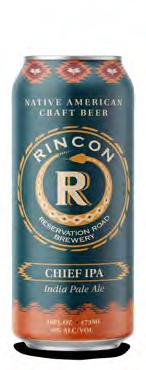
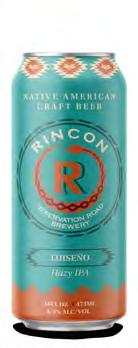


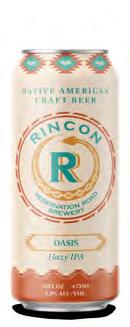
– This is Our Gift to You, Savor the Journey

Diego County




Vintners Association





2023 VINTNERS WINE FESTIVAL
annual Diego County
Vintners Wine Festival caps
San Diego Wine Week, week-long celebration of Diego wines and wineries. the only wine festival exclusively showcasing Diego Wines.




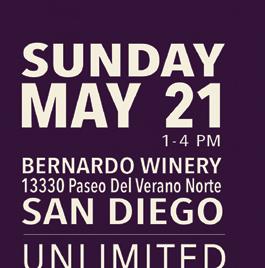
San Diego County (south of Temecula to the Mexico border) is home to over 140 wineries and vineyards. The region continues to gain acclaim from wine enthusiasts who say we are just beginning to unlock its full potential as an important wine region in California. The county’s complex terroirs with varied microclimates have been perfect for wine grape growing since the first Spanish friars set foot in San Diego and began the tradition of viticulture in California.
The ways to enjoy San Diego wine are diverse, too. From stylish urban wineries, to awardwinning tasting rooms and picturesque vineyards, San Diego provides an array of ways to discover artisanal wines. Next time you’re looking for a relaxing adventure in San Diego County, pick a winery, pull up a chair and be prepared to sip some delicious wines made with heart.

Save the Dates: Wine Week 2024 – May 13-19.






Vintners Wine Festival 2024 – May 19



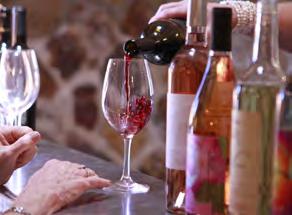
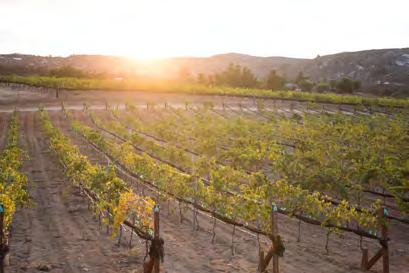










For more information on local wineries visit: SANDIEGOWINERIES.ORG

20 ediblesandiego.com
SA N D IE G O CO UN TY . . . WH ER E C ALIF O RNI A W IN E BEGAN S A N DIEGO WHERE C A LIFORNIAWINE BEG A N
rincon
VALLEY CENTER 777 Harrah’s Rincon Way, Valley Center, CA 92082 3rbrewery.com
CIDERIES OF SAN DIEGO
HARD CIDER IS SURGING THANKS TO ARTISANS AND GROWERS ACROSS THE COUNTY
BY MICHELLE STANSBURY
Naturally gluten-free, cider has long been a popular alternative to beer for those with allergies and sensitivities. Craft cider actually has far more in common with wine than beer—in fact, it is technically wine! Local hard cider producers are further elevating the beverage by cultivating a San Diego terroir through the use of homegrown apples along with naturally occurring yeast for fermentation to give a hyperlocal spin to the drink. Other cideries are reintroducing traditional styles in a nod to the long history of the boozy beverage.
Although Julian is nearly synonymous with apples, the region doesn’t produce enough of the water-intensive crop to fulfill our desire for locally grown cider apples. Beth Demmon, author of The Beer Lover’s Guide to Cider: American Ciders for Craft Beer Fans to Explore (Mango, 2023), says that while San Diego isn’t wellknown as an apple-growing region due to our weather conditions, local growers are looking to sustainable methods to increase production: “Water conservation is always top of mind for local growers, and they tend to grow hardier varieties that can still grow in the heat.”
“During apple-picking season, it’s a long-held American tradition to drink cider during the harvest, so cider tends to be popular during fall. If you’ve tried cider before and think you don’t like it, try again,” Demmon says. “Many people across the US have misconstrued notions about what cider is—sweet, sticky alcopops with tons of sugar. That’s just not the case. There are tons of craft cider makers who specialize in dry ciders with a huge range of

flavors and finishes.”
Demmon’s advice is to “try to forget what you think you know and be open to finding out something new, preferably at a small or regional cidery rather than a nationally distributed maker on standard grocery store shelves.”
Across San Diego County, here are some of the top spots to try locally made cider.
Raging Cider & Mead Co
San Marcos
Raging Cider & Mead Co focuses on English-style ciders, which owner Dave Carr shares were his first love. “We make a cider called Wynola Scrump, which is reminiscent of these ciders and is made with a locally grown crabapple and a subacid aromatic apple.” According to Carr, cider can take on a more interesting complexity by using native fermentation. “All of the ciders we make are fermented utilizing the natural yeasts on the fruit, which helps to create a true San Diego County terroir to the wines that we produce.”
Raging Cider has also rescued orchards in Julian and Guatay through its orchard rescue program. At all the orchards they own

| DRINK
FERMENTING IN SD
or manage, they use regenerative methods. Carr explains, “We do not till to allow the plants to sequester carbon in the soil. In addition, at our homestead orchard, we only use inputs such as an onsite compost and compost tea, fish and seaweed emulsion, nematodes, and, in a worst-case scenario, an organic spray for a particular disease. We grow winter and summer cover crops, which get mowed in to enrich the soil, and we add woodchips around our trees.”
Newtopia Cyder Scripps Ranch
Rick Moreno, founder of Newtopia Cyder, hosts a farmers’ market that began during the pandemic to raise awareness of nearby businesses and create a safe environment to taste their cider. The “cyder” spelling pays homage to the Old English style of cider making. Moreno shares, “We partner with orchards all across Northern California, Hood River, and Yakima to source our West Coast five-apple blend. [Fermentation] is an art… almost like being a baker, we create the right environment with the hope that it comes out wonderful on the other side. The science is controlling the flavor of our cider with a proprietary yeast strain that’s strong enough to ferment bone dry.” Try the Chai Me A River, which is dry-spiced with a decaffeinated blend of chai spices, chamomile, and chrysanthemum flowers.
Storum Ranch Cider & Wine
Julian
At Storum Ranch Cider & Wine, all apples used in their cider are grown on their Julian ranch, home to 2,500 trees at the foot of Volcan Mountain. Bill and Pauline Storum are currently grow about 60 varieties including GoldRush and Hewes Virginia Crab. Pauline Storum shares that all of their apples are picked by hand and the trees are treated with a combination of love and science. “We’re at 4,200 feet above sea level and generally get 1,000 chill hours each year. Chill hours refers to how many hours the temperature is below 45°, and different types of apples require different minimum chill hours in order to produce,” Pauline explains. “For example, our Fujis and Galas need 350 to 400 chill hours, and our Northern Spy needs 1,000. We use a high-density orchard trellis system on primarily dwarf rootstock, which allows us to maximize production, and we have drip irrigation throughout the orchard. The orchard is fully enclosed by a deer fence, and as the fruit grows, Bill places streamers and squawkers to keep birds away. Bill is in the orchard daily, monitoring the trees and the

drippers, assessing the fruit set and development, and thinning by hand as needed.”
Storum specializes in single-varietal ciders as well as traditional blends, like Harrison-Campfield and Redfield-Dabinett, in order to let the quality of the apples shine through. Before Prohibition, the Harrison-Campfield blend was known as “Newark Champagne” and was considered the best in America. Now, it is reborn with a San Diego spin at Storum where they currently have the 2018 and 2019 harvests on tap.
Calico Cidery
Julian
Calico Cidery is committed to only sourcing locally in order to cut down on transportation emissions. Primarily, they use apples and pears from their own orchard, though they also partner with a few other orchards in the Julian area. Cider maker Ian Wright shares his perspective on the fruit grown nearby: “The hot, dry growing conditions especially in the fall in Julian create very unique, intensely rich apples that are perfect for cider. We are very careful about our water use, when we water and how, and try to dry farm our older apple trees as much as possible. We currently are inoculating chipped mulch from our own fallen oaks with a culinary mushroom called King Straphoria that creates a dense, mycelium-rich mulch that we plan to spread into our fields and hopefully be able to harvest edible mushrooms from as well.”
Try Calico’s Devil’s Punchbowl, a summer blend of apples and pears from their farm with persimmons and guavas from the San Diego coast.

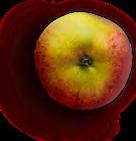


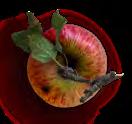


Bivuoac Ciderworks
North Park
In the North Park taproom, Bivouac Ciderworks shines a light on cider history, sourcing, and production. Bivouac is debuting a new concept this fall, the Bivouac Adventure Lodge, which will be adjacent to the current taproom and triple the cidery’s square footage, helping the company increase production. A tasting experience, similar to that at a winery, will highlight the distinctions between ciders.
Try Bivouac’s Savoy English Pub Apple Cider, classic cider. Bivouac sources their traditional bittersweet Dabinett apples from the English counties of Herefordshire and Worcestershire, where the orchards can forgo irrigation due to the climate and ample year-round rainfall. The Bivouac taproom also serves other local, smallbatch ciders on draft, such as Storum Ranch.
Oddish Wine Bay Park
Oddish Wine’s take on cider is a 100% Newtown Pippin cider aged on cab franc grape pomace called “This Is Cider?” Owner Billy Beltz realized he could source Newtown Pippin apples from an orchard in his hometown of Santa Cruz and was inspired to make a special cider. “We decided to take the resulting cider we made from those apples and age them on cab franc grape pomace from our friends at Gianni Buonomo Vintners, a local winery here in San Diego,” Beltz shares. “The result is a complex and bone-dry cider with a bright red-orange hue, vinous and fruity aromas, and a wonderfully tannic and refreshing finish.”
Twisted Horn Mead & Cider Vista
Since Julian apples are in short supply, Vince Obarski, owner of Twisted Horn Mead & Cider, gets most of their apples from Washington and Oregon. While the flavors rotate seasonally, Obarski shares that his all-time favorite is Thyme for Change. “I made the cider with apple, blueberry, lemon zest, and German thyme. I would say that right now the most popular would be Potions or Gems where we used apple, brown sugar-roasted pineapple, blood orange, and pink guava, making it perfect for the warmer months.” The tasting room in Vista has a unique appeal, which Obarski describes as “Vikings meets Middle Earth—so if you have a drop of nerd blood coursing through your veins, you will want to live here.” D

MORE SAN DIEGO CIDER TO EXPLORE

Turquoise Barn Cider
Ramona


Julian Hard Cider

Julian
Serpentine Cider

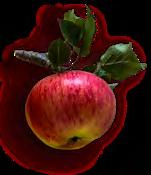
Miramar and University Heights



Guthrie Ciderworks
Miramar
FALL 2023 | edible SAN DIEGO 23 | DRINK
100%
perennialpasturesranch.com
PASTURE TO TABLE
GRASS-FED BEEF
FALL WORD PLAY
Across
1 Ratatouille ingredient
4 Herbs and vegetables
8 Before, prefix
9 Fall
10 Fruit of the vine

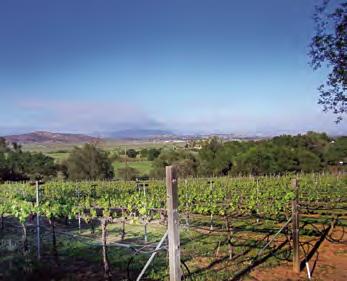
15 ____ the table
5 Pea or bean
6 Approaches
7 Type of wheat
12 Orange tuber
13 A pair of
14 Bard’s nightfall, abbr.
16 Corn section
18 Tinted
19 Reuse creating higher value
21 Wire service
24 Egyptian sun god
26 Soil
27 Globular yellow fruit
28 Cook meat
29 Dig
30 Exist 31 End of grace
33 Turn over soil
Carlsbad resident Myles
Down
1 Show communal spirit by providing food to others

2 Lik e virgin land
3 Add up
4 Media handler

Mellor is one of the top crossword and puzzle writers in the world. He has published over 55 crossword and word search books, producing dozens of puzzles each month.

» mylesmellor.com

» themecrosswords.com
Answer key on page 48.
Enjoy
24
ediblesandiego.com
11 Environmental group functioning as a unit
17 Dandelion or goldenrod, e.g. 20 Purplish-blue plum 22 BBQ setting 23 ____ chef- junior cook 25 Container 27 In fall, it’s often covered with leaves 30 Azerbaijan’s capital 32 Autumn drink made from apples 34 Cry of discovery 35 Fruity preserve 37 Run up a tab 38 Breakfast staple 39 Good for the body or mind
36 __, shucks!
Woof ‘n Rose Winery
our
international, award-winning wines on our sheltered, outdoor veranda, overlooking our
and the Ramona Valley, while surrounded by almost 180 degrees of mountain views! woofnrose.com ~ 760.788.4818
in this ad to receive Two Tastings for the Price of One SAN DIEGO'S CACAO CAFE ORGANIC TREATS FARM-TO-TABLE EATS 3349 Adams Ave, Normal Heights Open Tues-Wed 7-6, Thu-Sat 7-10, Sun 7-8 TRY OUR HOUSEMADE LOCAL HONEY MARSHMALLOWS & GF VEGAN PASTRIES!
national and
vineyards
Bring
CUPS OF WISDOM
THESE TASTE LIKE A WAFFLE CONE AND REDUCE PLASTIC AND FOOD WASTE
STORY BY JULIE PENDRAY • PHOTO COURTESY OF AMAI EARTH CUPS
Imagine enjoying ice cream in a cup at the end of the day and then not having to think about washing a dish or disposing of trash. Instead, eat the cup, turn off the lights, and float off to bed. In the morning, grab another of these slightly sweet cups for your coffee, yogurt, cereal, or berries. Munch on the nutty flavor and pat yourself on the back because you’re helping to keep brewers’ spent grains like barley, wheat, and oats (waste from beer making) out of landfills, potentially reducing global warming. As more and more consumers choose products aligning with their climate consciousness, the longrange vision of Amai Earth Cups based in Carlsbad is to supply not only edible cups but also plates, trays, and other food service items. With early success in their new business, they’re planning to expand into a major production facility to fill growing orders.
The New York Times announced as we went into 2022 that “edible containers are a food revolution.” Upcycling (treating food byproducts for human consumption) is key, and spent grains should be a major focus according to a report this year by international peer-reviewed scientific journal, Foods: “Harnessing this byproduct and developing sustainable processes is an urgent need in the food industry.” While most spent grain has gone into animal food, the report notes that it’s valuable for human consumption “because it increases the protein, fiber, vitamin, and mineral contents while decreasing the starch and caloric content in grain-based products.” The byproduct has benefits known to work against obesity, diabetes, colitis, neurodegenerative diseases, certain cancers, and cardiovascular diseases.
The Amai business idea came to owners Jeannine and Sven Davison in the form of a photo from Norway sent by a
vacationing friend in 2020. It showed an edible cup at a coffee house. The Davisons thought, “Why don’t we have them here?” Armed with experience from backgrounds in manufacturing and executive operations (in film and media), they made a successful proposal to the cup manufacturer in Bulgaria and became the US importer and distributor. Later, realizing the opportunity to generate the cups locally, they presented a plan to produce the cups in the US. “It didn’t align with the Bulgarians’ growth strategy,” says Jeannine Davison. The Davisons decided to begin making them here themselves. They made prototypes on their home waffle iron before raising $700,000 for production equipment and a test facility in Vista, where they can make up to 10,000 cups a month. Now, with large orders from major companies in food service, they are on a mission to raise $4.5 million to grow to scale and keep the test facility for research and development.
They are seeking assistance from the County of San Diego and various investment groups. “The spent grain recovery equipment could be on the back end of a brewery or the front end of our facility, or it could be a hub where all the spent grain goes,” Davison says. The byproduct has to be dried and milled before use.

Amai Earth Cups are tolerant to heat and moisture, so they can be used for soup, lattes, gelato, dips, snacks, salads, and more. The Davisons have a recipe patent pending for the cup. To learn more about Amai Earth Cups, check out their website, Facebook, and Instagram @amai.earth. D
» amai.earth
FALL 2023 | edible SAN DIEGO 25 | DRINK
LIQUID ASSETS
RESCUING FOOD NEVER TASTED SO GOOD
ONE KITCHEN COLLABORATIVE CREATES A ZERO-WASTE NONPROFIT FOOD BUSINESS MODEL THAT ACTUALLY WORKS
BY RYAN RIZZUTO • PHOTOGRAPHY BY DEANNA SANDOVAL
Food waste in America stacks higher and higher each year. According to Feeding America, the number now stands at 119 billion pounds of food piled up in landfills instead of plates. There’s no question that restaurants and food establishments can and should be making more of an effort to waste less, and the team at One Kitchen Collaborative in Oceanside is a local leader of this movement.
Vibrant and creative, Vallie Gilley has boundless energy when discussing her passion for redirecting usable food from the landfill into meaningful and delicious meals for her community. Several years ago, the seasoned chef and owner of Jitters Coffee Pub in Oceanside found herself puzzled by the significant quantity of waste produced by the food and beverage industry. California Senate Bill (SB) 1383 aimed at curbing residential and industrial food waste statewide had not yet been adopted, but Gilley decided it was time to take action so a system could be in place to make the goals of the bill possible in her town.
Meanwhile, North County chef and caterer Keith Lord of Stratәjē Fourteen was also wrestling with the crisis of food waste in the industry. “I’ve always tried to preach zero waste in the kitchens that I’ve worked in,” says Lord. To his dismay, it was a challenge to inspire chefs to share in his dedication to waste reduction. Although waste-reducing strategies prove to boost the bottom line of an already fickle industry, it often requires more time and skill to innovate ways to utilize scraps that are simply easier to throw away.
Chef Lord met his match when Gilley approached him to pursue a zero-waste catering kitchen offering culinary learning opportunities dedicated to wasting nothing and feeding the community. Gilley collaborated with the City of Oceanside to secure grant funding, and in 2019 launched One Kitchen Collaborative (OKC), initially known as O’side Kitchen Collaborative. She joined forces with Green Oceanside, a local sustainability collective associated with the city, to build a state-ofthe-art food recovery and preservation facility designed to foster a sustainable food system. This collaboration was an early blueprint for public-private partnerships in food waste reduction.
“What’s cool about OKC, that no one really knows, is that we built its kitchen at the landfill wondering how much waste we’d be able to divert before it hits the landfill. We quickly became the model for what to do,” Lord explains.
Just as the fledgling organization found its footing, though, the challenge of the global Covid-19 pandemic presented itself. As many nonprofit organizations did at the time, OKC had to pivot and remain relevant. They kept their zero-waste ethos but applied
it to mass hunger-relief operations. Gilley says, “Our kitchen has been able to feed nutritious meals to community members who need it the most, including our elderly, our immunocompromised, and our homeless San Diegans.”
The team worked around the clock and relied on volunteers to help cook, package, and distribute hundreds of thousands of meals during 2020. Oceanside’s mayor, Esther Sanchez, lent a hand on the assembly line. “During the pandemic, the city ended up doing a contract with OKC to prepare meals for our homeless and those that were having trouble getting food. [Gilley and her team] ended up doing very, very close to a million meals. I actually volunteered one day—it’s amazing how they can make warm meals for people and really deliver quality,” Mayor Sanchez recalls.
“We even hired laid-off restaurant workers who could have made more money had they stayed home and collected unemployment but they chose to work here because of the amazing mission we’re on,” Gilley shares.
As emergency response to the pandemic eased in 2021, the team at OKC looked to revive its identity and approach to zero-waste cooking. They relaunched their “conscious catering” operations to provide delicious menu options prepared from ingredients that would otherwise be discarded. Meal production resumed for local schools and senior centers to infuse healthy, zero-waste cooking methods into daily meals and educate multiple generations on the importance of food waste reduction.
Now, OKC produces vegan ingredients at scale to sell to chefs who want to embrace zero-waste cooking but lack the facilities and resources that OKC dedicates to this mission. These specialty ingredients are made in-house at the OKC kitchen and include vegan cashew mozzarella, plant-based picadillo, a “not-yo cheese” vegan nacho cheese, and a sunflower seed sunrizo (a chorizo substitute).
Oceanside’s premier restaurant scene is adopting some of OKC’s specialty ingredients and local chefs are experimenting with them on their menus. “[Gilley] had a bunch of really great ideas for trying to use up some of the produce that was getting wasted on farms. They brought us a bunch of samples. I started buying jams and pickles that were made from less-wanted produce,” says chef Samantha Parker of Privateer Coal Fire Pizza. “When we go to do menu changes, we always reach out to them and try to get some ideas from them about what they would like to create for us. Then we collaborate to find something delicious to put on our menu.”
Chef Parker and OKC developed the OKC Pie, a Southwesternstyle pizza with romesco verde, OKC vegan cashew mozzarella, OKC sunrizo, OKC corn salsa, and OKC brazil nut parmesan.
26 ediblesandiego.com
SHARE |
Additionally, OKC’s “fysh” tacos make a splash on the Privateer menu and are made from coconut flesh.
When speaking about these delicious dishes, Mayor Sanchez is a huge fan. “Getting to zero waste is actually possible. We throw away so many fruits and vegetables and the idea that OKC uses just about everything—they leave nothing on the table when they cook—is amazing.”
The partnership between the City of Oceanside and OKC is a testament to the power of hard work and patience. Both city workers and OKC staff waded through the nitty-gritty details of grant applications, navigated bureaucratic red tape, and found triumph and purpose through a pandemic. Michelle Geller, the city of Oceanside’s economic development manager, knows the beauty of this partnership well. “I first encountered OKC right when I started working for the city. They were catering an event that I was attending. I had their food and I was blown away. When I learned that they were a zero-waste kitchen on top of everything else, I was doubly blown away,” she shares. Geller believes Oceanside is on the cutting edge of sustainability in the
industry and sees the potential for current and future food and beverage businesses in the city to collaborate with OKC on zerowaste education and initiatives. “My goal is business retention in Oceanside. A zero-waste kitchen affects the bottom line, so OKC has been really great about getting the word out in educating restaurants on how to be zero waste,” Geller says.
Whether you experience OKC in the crunchy first bite of a “fysh” taco at Privateer, fill up your plate at one of their conscious catering events, or receive a meaningful meal as a student or senior, rest assured that OKC is cooking up a better future for us all.
“They’ve shown that this is a pretty phenomenal model that they’ve created,” Mayor Sanchez emphasizes. “I think it’s a great model to be exporting out to other communities.” D
One Kitchen Collaborative invites you to visit their website for more information on their conscious catering and happenings like their monthly taco night on the first Tuesday of every month at Jitters Coffee Pub.

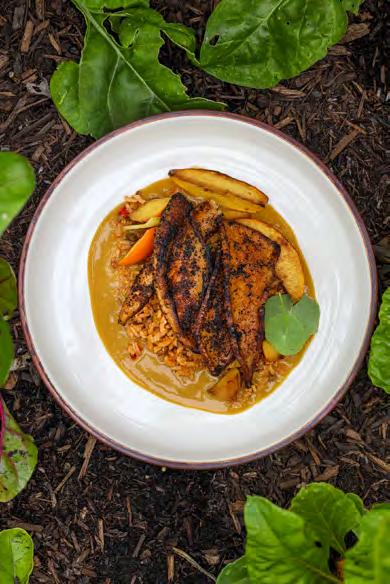

» theokc.org

FALL 2023 | edible SAN DIEGO 27
Clockwise from above: OKC turns coconut flesh into a seafood substitute suitable in a variety of recipes from Baja-style tacos to this blackened “fysh” curry dish with sunrizo dirty rice, roasted apple, and sweet potato; Vallie Gilley grew up in Oceanside and opened Jitters Coffee Pub in 2000; chef Keith Lord and OKC’s director of sales and engagement, Crystal Johnson; Privateer’s OKC Pie with vegan mozzarella and sunrizo.
Zinfandel









28 ediblesandiego.com Experience Ramona Ranch Wines SAN DIEGO'S ONLY CERTIFIED SUSTAINABLE VINEYARD & WINERY OPEN FRIDAY - SUNDAY 11 TO 6PM LOCALLY HANDCRAFTED WINES 23578 Highway 78, Ramona ramonaranchwines.com Open for Tasting and Sales Saturdays & Sundays 11-5 910 Gem Lane, Ramona, CA chuparosavineyards.com 100% Estate Grown, Produced and Bottled
VALLEY WINES
RAMONA
| Sangiovese | Malbec
Franc | Dry Rosé 100% Estate Grown, Produced and Bottled SAN DIEGO COUNTY WINES
Cabernet
| Malbec Cabernet
| Albarino Open for tasting and sales Saturdays & Sundays 11–5 910 Gem Lane, Ramona, CA chuparosavineyards.com
Winery
CA
Saturdays 11am–6pm scenicvalleyranch.com 100% ESTATE WINES RHÔNE VARIETALS HOURS SATURDAY 11–5 SUNDAY–FRIDAY BY APPOINTMENT MENTION THIS AD FOR 10% OFF PURCHASE MERMAID VALLEY VINEYARD 760-315-9011 mermaidvalleyvineyard.com
Zinfandel | Sangiovese
Franc
Boutique
27012 Scenic Valley Rd. Ramona,
92065 Open
ALL EYES ON CLAUDETTE
A MOTHER, CHEF, PHILANTHROPIST, AND AUTHOR DISHES ON WHAT DRIVES HER AND THE LEGACY SHE’S
BUILDING
BY BETH DEMMON • PHOTOGRAPHY BY LAUREN DI MATTEO
With her trademark glasses and signature flowing hair often styled in long green braids, chef Claudette Zepeda is easy to spot in and out of the kitchen. She’s been a central part of many kitchens in the past like El Jardín and Bracero, with appearances on Top Chef and Iron Chef, to name a few. But being the founder of Chispa Hospitality and Viva La Vida, and culinary director of VAGA at Alila Marea Beach Resort in Encinitas are her latest—and arguably greatest—projects to date.

Perched steps from the Pacific, VAGA’s panoramic views are impressive, but the food and drink programs grab all the attention.
Creating an experience at VAGA takes
plenty of planning and flexibility. Zepeda says, “I know what a dish needs to have to be successful,” listing characteristics such as the balance between things like salinity, acidity, and sweetness, as well as where it should fall along the Ayurvedic scale of “hot” and “cold” food. There’s a whole process she goes through.
“I literally draw a Venn diagram. In the middle it says what the protein is, or what the star of the dish is,” she explains. She starts connecting her ideas together—what’s the texture? where’s the acid?—and at the end, “I’m looking at the full picture.”
Zepeda also draws inspiration from sustainable or locally sourced and seasonal ingredients. VAGA’s Elements of Nature, a quarterly special event dinner series for 2023, allows her to attune her creative energy alongside moon cycles to orchestrate delectable five-course dinners. Nature of Fire debuted in March, followed by the Nature of Earth in June, with Nature of Air on September 21 and Nature of Water on December 21 still to happen. Zepeda describes it as a “transcendent” dinner series, one that she hopes will change the way people look at our shared relationship with the Earth.
“Connecting with nature is super important to me,” says Zepeda, pointing to Indigenous traditions of honoring seasons and cycles as a sacred ritual modern-day society has lost.
But Zepeda is more than a chef. She’s also a mother, author of the upcoming book Borderlands (which will celebrate her
culinary cross-border influences between Mexico and the US), and a staunch advocate for mental health resources, especially across hospitality, and for the rights of farm and migrant workers. As an ambassador for Southern Smoke, a nonprofit benefitting food and beverage workers with resources like financial aid and no-cost mental health programs, she feels a responsibility to make sure the path of those following in her footsteps have an easier journey.
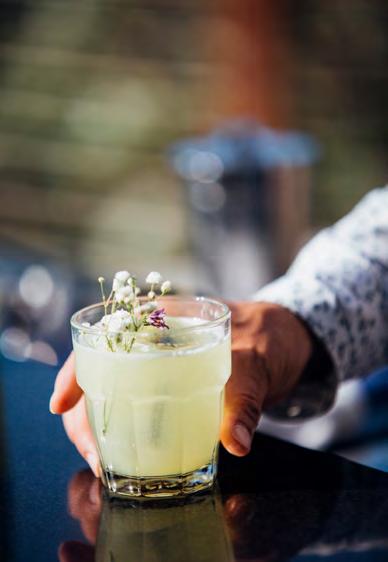
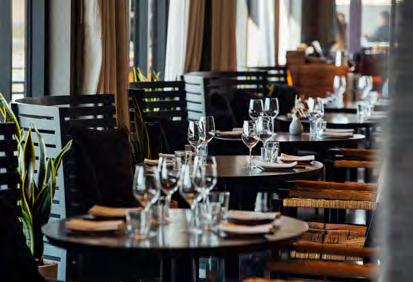

“You can no longer hold it in and just pretend to be this rockstar chef and not talk about the mental health toll that it takes on you,” she says. An aggressive culture that rewards overwork, punishes burnout, and celebrates brutal behavior is something that’s haunted hospitality for decades, but it pushed many beyond their limit during the pandemic. “People won’t work to be treated like shit anymore. No matter where they work, no matter how great of a restaurant it is, your skeletons are coming out of the closet if that’s how you treat people.”
She recounts kitchens in her own past with toxic cultures and energies, hoping that her work today helps the people of tomorrow. “Just because I suffered doesn’t mean the next generation has to,” she promises.
But her advocacy extends past kitchens, all the way to farms and across borders. According to the Centers for Disease Control and Prevention, farm workers are far more susceptible to anxiety, depression, and suicide than the average population. It doesn’t have to be this way, says Zepeda, but we as a society have to stop
30 ediblesandiego.com SHARE |

turning a blind eye in favor of low cost and convenience. These issues are happening both abroad and right here in California.
Zepeda describes driving through California’s agricultural centers and seeing workers—many underpaid or undocumented migrants, often from Mexico—laboring in harsh conditions and bad weather, and receiving little pay for dangerous work. Americans have become accustomed to cheap food without considering the true costs or who pays them.
Xenophobia also plays a role, one that’s harder to parse into a cost and value analysis. “It’s not just teaching humans the cost of our industry. How do you teach that when they don’t see certain people as actual humans?” she wonders. That’s why she works with agricultural unions and activist groups to advocate for safe working conditions, equitable pay, paid time off, and all the benefits human beings should have under a just system. In 2019, she founded Viva La Vida, LLC, with the goal to help Mexican women “support their families without sacrificing their safety,” according to the group’s mission statement. She plans to establish a formal 501(c)(3) this year.
All this work abides in her kitchen as well. VAGA’s pay scale falls well above minimum wage, and she says a nonnegotiable part of her coming on board before opening was ensuring wage gaps between roles were narrowed. “The two most important people in my restaurant are my host and my dishwasher,” she laughs. “Some people say it’s the wrong way to lead, but I treat my staff like family. I call them my kids.” And by imparting the same elements of delegation and self-improvement to her staff as she does her actual children, Zepeda hopes to build a legacy that outlives her, both in and out of her kitchens. So far, it sounds like she’s on her way. D
Reservations for VAGA are strongly encouraged. Tickets for the Elements of Nature dinner events in September and December start at $125 per person, with a curated wine pairing available for an additional $25 including tax and gratuity. Reserve seatings at 5pm or 7pm at vagarestaurant.com/events. Follow chef Zepeda on Instagram at @claudetteazepeda.

» vagarestaurant.com
» chefclaudettezepeda.com
32 ediblesandiego.com
SHARE |
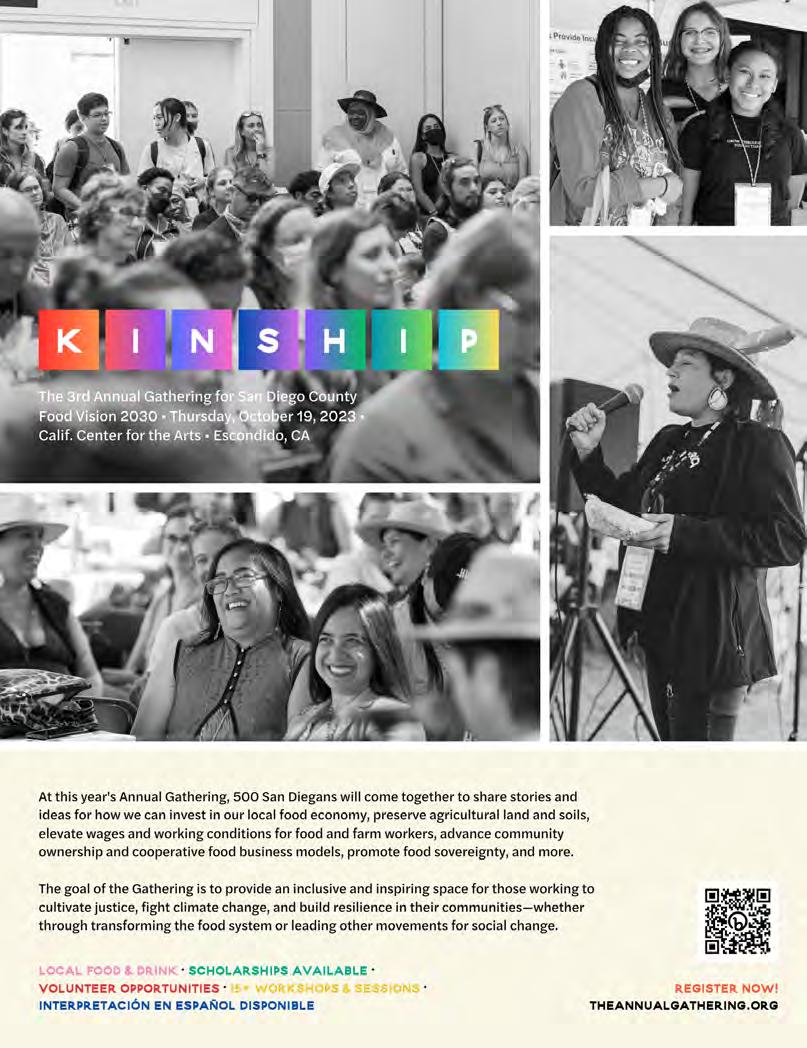
INTENTIONALLY REGENERATIVE
DR. BRONNER’S CLEANS UP STANDARDS FOR GLOBAL PRODUCERS
BY PAUL HORMICK • PHOTOS COURTESY OF DR. BRONNER’S
Anyone who has taken enough time and endured the eyestrain of reading the 0.2 type on a Dr. Bronner’s product label knows that the soap manufacturer promotes the goodness and unity of humanity. That commitment has turned the Vistabased company into a worldwide leader, setting new standards in regenerative agriculture.
In 2005, David Bronner, CEO (cosmic engagement officer) and grandson of the original Dr. Bronner, realized that to adhere to his company’s core principles, they needed to go beyond the organic certification that they had earned two years earlier. “The problem with organic as a standard is it’s more about what you shouldn’t do and not what you should do,” Bronner says. Organic certification bans synthetic fertilizers and pesticides yet gives no direction on maintaining soil fertility or sequestering carbon.
The family-owned company reached out to the Rodale Institute, a leader in organic farming, to develop the most advanced and comprehensive standard for regenerative farming. Patagonia, the clothier known for its corporate consciousness, and other organizations also got on board. In its simplest terms, regenerative farming recognizes that soil is more than just dirt. Microorganisms, fungi, worms, and other organisms create a holistic living system that retains water and increases crop yield while sequestering carbon in the soil. The new standard, Regenerative Organic Certified, was launched in 2018. Dr. Bronner’s promotes intercropping, the cultivation of two or more crops simultaneously. Crops are also rotated through annual cycles, including noncash cover crops that are grown to put nutrients into the soil. In many cases, Dr. Bronner’s is the majority owner of a farm or the largest customer, which helps it enforce its standards.
In places like Ghana, the soap-making company (and now chocolate-making!) supports dynamic agroforestry. Crops such as cocoa and oil palm are densely cultivated along with bananas and papayas. “You’ve got different canopy heights of complementary tree species. It’s like a wild ecosystem. You have tall trees, mid-level
trees, bushes, and ground cover,” says Bronner. “That maximizes photosynthetic capture and biomass yield and minimizes weed and pest pressure.”
Coconut, palm oil, mint, and other raw materials come from countries as diverse as Ivory Coast, Madagascar, and India. As conditions in each country and each crop differ, the new certification sets no exact farming rules. “What we are mandating is that your soil health needs to be increasing year to year,” Bronner says. “That five years later a farm can show measurable improvement in its soil quality.”
Moving Beyond the Soil
To develop animal husbandry standards, Dr. Bronner’s worked with Compassionate World Farming, an organization that advocates for more humane treatment of farm animals. Bronner says, “We want no confined factory farms, no confined systems. It all has to be pasture-based, where the animal lives a good life and fulfills instinctual behaviors.”
He also realized organic certification gave little visibility into conditions for farmers, workers, and their communities. Nothing in the certification covered wages or working conditions. Developed with the Fair World Project, regenerative certification bans child or forced labor. It mandates living wages and bans sexual harassment. Farmers must receive a fair price for their crops, and food processing must be done in a facility that pays good wages.
Bronner encourages other businesses to follow their lead and adopt responsible practices. “Companies that make a like-minded choice, you’ll increase your costs somewhat, but you’re doing a responsible ecological thing,” he says. “Doing the right thing can be very lucrative. We’re an economically thriving and growing business. There are increasing numbers of consumers that want to be assured that the people involved in making their products and growing their food were not shafted and weren’t exploited.” D
» drbronner.com
34 ediblesandiego.com
SHARE |

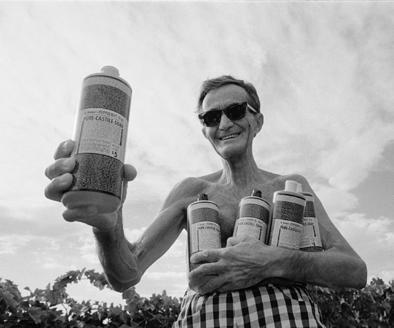
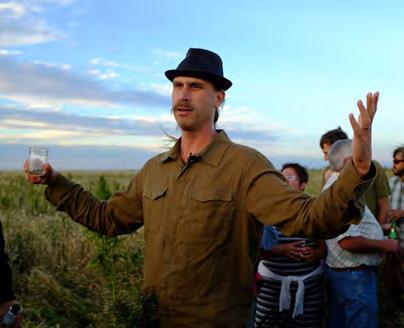
FALL 2023 | edible SAN DIEGO 35
Top left to right: Dr. Bronner’s was started in 1948 by Emanuel Bronner; David Bronner (photographed here by Matthew Staver at the Colorado Hemp Festival) has become a vocal activist on the topics of fair trade, animal welfare, and therapeutic psychedelics. Bottom: Coconuts at a fair trade producer in Sri Lanka.

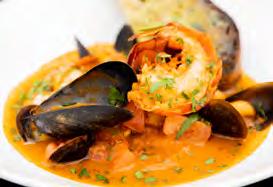

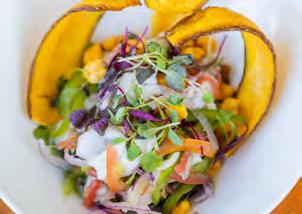


Located at the Bahia Resort Hotel (858) 539-7635 | 998 West Mission Bay Drive | San Diego, California
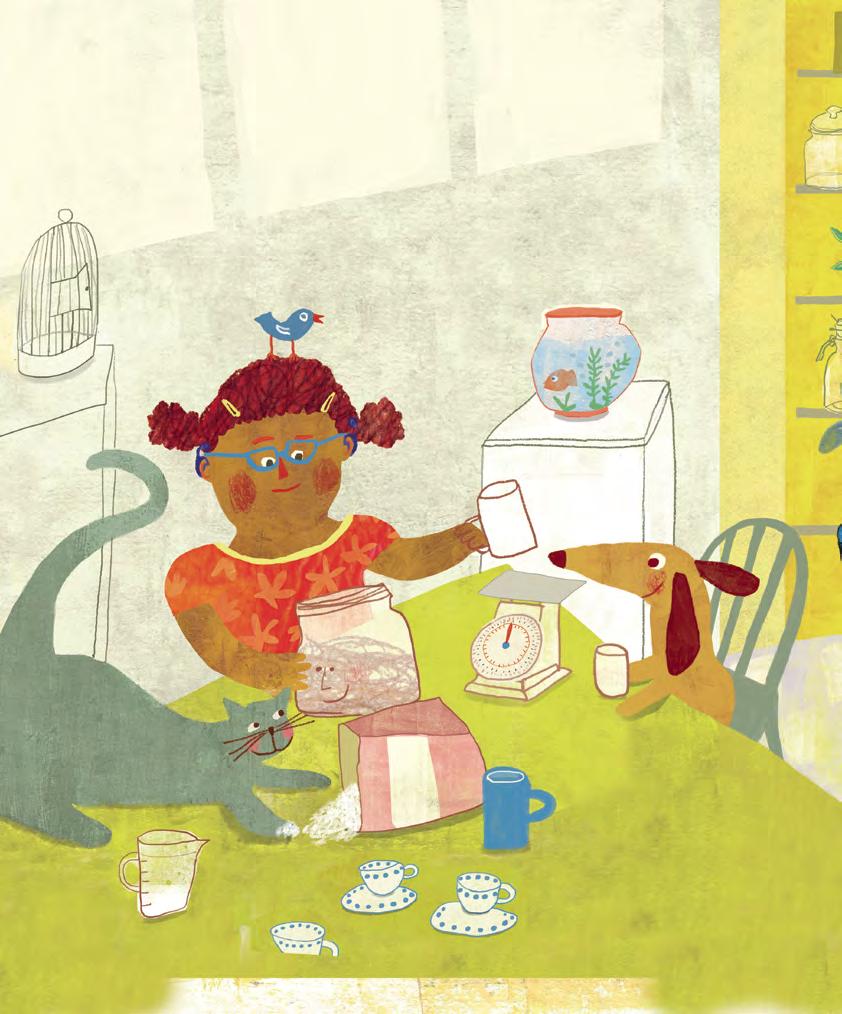






FALL 2023 | edible SAN DIEGO 37 Activities, recipes, stories (and more!) created for family sharing The Bread Pet Illustration adapted from The Bread Pet (Barefoot Books), written by Kate DePalma and illustrated by Nelleke Verhoeff is created in partnership with indie, award-winning, Concord, MA-based children’s publisher, Barefoot Books. Learn more by visiting www.barefootbooks.com. CUT ME OUT! Cora promises to keep Uncle JB’s Bread Pet alive but didn’t anticipate its exponential growth! She needs to come up with a solution — and fast! barefootbooks.com/bread-pet
MAKE YOUR OWN BREAD PET!
Sourdough Starter
Day 1: Mix
1. Place an empty jar on a kitchen scale and set the scale to zero.
2. Add 100 g (⅚ cup, or ½ + ⅓ cup) of flour and 100 g (about ⅖ cup or 6 ½ tbsp) of water to the jar.
3. Stir until all dry parts are mixed in.
4. Keep this mixture somewhere warm, between 70°F to 75°F, but out of direct sunlight.
Day 2: Feed
1. Place another empty jar on the kitchen scale and set the scale to zero.
2. Scoop in 200 g (about 1 cup) of the mixture you made on Day 1. Compost or throw away the rest (this will make sure your Bread Pet stays a manageable size).
3. Add 100 g (⅚ cup, or ½ + ⅓ cup) of flour and 100 g (about ⅖ cup or 6 ½ tbsp) of water.
4. Mix well until all dry parts are mixed in.
5. Cover and place in the same warm spot as Day 1.
6. Repeat steps 1–5 daily for at least 5 days.
Congratulations, you’ve just created your own Bread Pet. Now you’re ready to bake some bread!
You’ll Need
∙ adult helper
∙ water (tap left out overnight or distilled works best)



∙ 700 g (about 6 cups) flour (rye or whole wheat works best)
∙ 2 clean glass jars
∙ kitchen scale (optional, but recommended for best results) or measuring cup
Note
Sourdough starters need a few days to ferment, or for the fungi and bacteria to produce the gases and acids that make the bread rise and give it its sour taste. They ferment faster in warm places and more slowly in cold ones.
Bread Pet Tips
∙ Keep your Bread Pet in a container with a loose-fitting lid so that it gets some air but doesn’t completely dry out.
∙ Feed your Bread Pet daily or keep it in the fridge if you want to feed it weekly instead. You can tell that your starter needs food when it is bubbling, at least twice its original size, and starting to collapse.
∙ If you don’t want to throw away the extra when you feed your Bread Pet, you can add it to dough for pancakes, waffles or crackers to make them extra tangy.
Are you passionate about children’s books that prioritize diversity, encourage critical thinking and teach kids to protect the planet? Learn more about becoming a Barefoot Books Community Bookseller! Visit barefootbooks.com/cb.


| created for family sharing CUT ME OUT! The Bread Pet
Let’s Bake Bread!
Mix
1. Whisk the Bread Pet, water and olive oil in a large bowl. Add the flour and salt.
2. Squish everything together with your hands until all the flour is absorbed.


3. Let it rest for 30 minutes.
4. Collect the dough into a rough ball.
First Rise
1. Cover the bowl with a kitchen towel. Leave it in a warm, sunny spot to rise.
2. Wait for your dough to double in size (3–12 hours, depending on temperature).
Stretch and Fold
1. Place the dough on a clean, floured surface. Coat your hands with flour.
2. Grab the far end of the dough and pull it up, stretching it without breaking it. Fold it back on itself.
3. Repeat step 2, stretching from the left, right and near ends of the dough.
4. Flip the dough over.
5. Repeat steps 2–4 a few times.
Second Rise
1. Cover the bottom of your Dutch oven with parchment paper or coat it with cornmeal to prevent sticking.
2. Place the dough inside for a second shorter rise, about 1–2 hours. It is ready when the dough is slightly puffy.
Bake
1. Preheat the oven to 450°F.
You’ll Need
∙ adult helper
∙ 150 g (1 cup) hungry Bread Pet

∙ 1 cup warm water (about 105°F)
∙ 2 tbsp olive oil
∙ 420 g (3 ½ cups) flour (bread flour works best)
∙ 1 tbsp salt
∙ parchment or greaseproof paper
∙ Dutch oven, casserole dish or heavy baking pot with lid
∙ kitchen towel

∙ serrated knife
∙ thermometer (optional)
∙ cornmeal (optional)
2. With the serrated knife, make a shallow slash about 2 in long in the middle of the loaf. You can make a few slashes if you want.
3. Place your Dutch oven, with dough inside and lid on, into your preheated oven. Reduce the oven temperature to 400°F.
4. Bake for 20 minutes.
5. Remove the lid and continue to bake, uncovered, for an additional 40 minutes or until bread is a deep golden brown.
6. Remove the bread from the oven and let it cool for at least 1 hour before slicing. Don’t cut too soon or else the inside will have a gooey texture!
FALL 2023 | edible SAN DIEGO 39 is created in partnership with indie, award-winning, Concord, MA-based children’s publisher, Barefoot Books. Learn more by visiting www.barefootbooks.com.
Cora promises to keep Uncle JB’s Bread Pet alive but didn’t anticipate its exponential growth! She needs to come up with a solution — and fast! barefootbooks.com/bread-pet
Illustration and text adapted from The Bread Pet (Barefoot Books), written by Kate DePalma and illustrated by Nelleke Verhoeff
ACTIVITY
Scoop of Thanks Meal
Start your meal with gratitude.
1. Find a large serving spoon to be your Scoop of Thanks spoon. Decorate it with stickers or ribbons.
2. Before you sit down to eat a meal with your family, pass the spoon around the table. When each person holds the spoon, they take a turn to say something they are grateful for. Listen carefully as each person speaks.
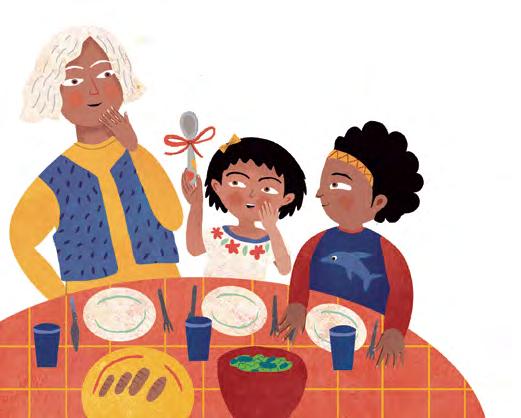
3. Keep the spoon somewhere special and use it once a week, every evening or however often you choose.
4. You could also keep a gratitude journal to draw or write down the things everyone shares at your Scoop of Thanks Meals.
You , ll Need:

• serving spoon
• stickers or ribbons
OPTIONAL:
• pencil or pen
• journal
Discover 50 unique games, crafts and mindfulness activities to help kids develop empathy and respect for themselves, their loved ones and the wider world.

40 ediblesandiego.com
is created in partnership with indie, award-winning, Concord, MA-based children’s publisher, Barefoot Books. Learn more by visiting www.barefootbooks.com.
CUT ME OUT! The Bread Pet
Illustration and text adapted from Kind Kids (Barefoot Books), written by Dr. Helen Maffini and Whitney Stewart and illustrated by Mariana Ruiz Johnson
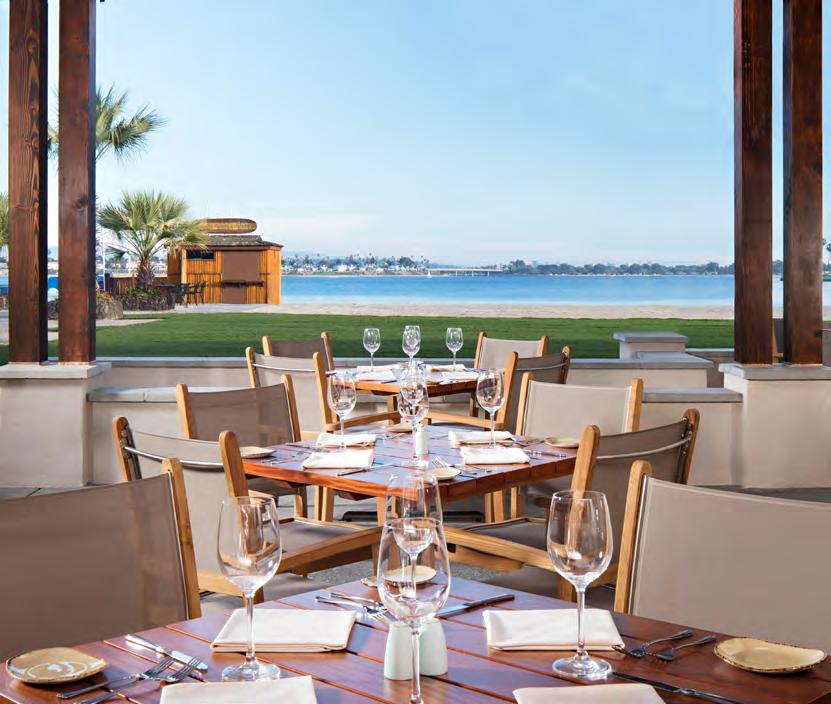
CALIFORNIA CUISINE HAS NEVER LOOKED BETTER Daily Breakfast, Lunch and Dinner Sunday Champagne Brunch Al Fresco Dining | Sushi & Seafood Options | Complimentary Parking Located at the Catamaran Resort Hotel and Spa | (858) 539-8635
SOUTHEAST SAN DIEGO COMMUNITY GARDEN AND UCSD LEARNING HUB MARKS 10 YEARS
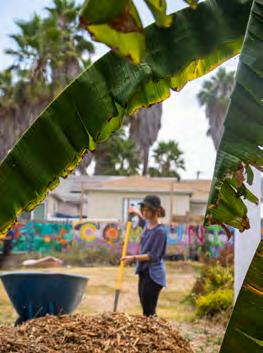
VOLUNTEERS AND PARTNERS HELP KEEP THE RECOVERED BROWNFIELD GREEN
BY CHERIE GOUGH • PHOTOGRAPHY BY MIA BALLESTEROS
Ocean View Growing Grounds (OVGG), a formerly vacant lot, has been transformed into a food forest where both nature and community thrive. This center of innovation and collaboration is celebrating a decade and taking its next steps to evolve into a powerful hub building community advocacy and leadership development.
Sustained people power is a key element to a thriving urban farm. Located adjacent to Barrio Logan, OVGG is considered a brownfield, an area containing hazardous traces of pollutants and heavy metals. This typically poses a complex challenge for healthy growing practices, but with a network of community partners, OVGG is growing stronger than ever.
Partnerships
The Global Action Research Center (Global ARC) is a nonprofit working to address poverty through grassroots action in research and policy. The organization funds OVGG’s land lease and employees, including site manager Thi Vo. The goal is to continue developing the program into a center that teaches community members tactics that build resilience to climate change and to have a voice in environmental policies.
Vo shares that a strategic part of Global ARC’s plan is to train neighborhood teen leaders. These Youth Environmental Justice Advocates learn about climate solutions, develop leadership and public speaking opportunities, and create youth-centered advocacy campaigns. Past projects include neighborhood beautification, addressing city council meetings, and teaching innovative gardening techniques to community members.
Also instrumental is OVGG’s partnership with professor Keith Pezzoli and UC San Diego’s Urban Studies and Planning Program. In Pezzoli’s innovative urban studies projects, students mapped out the city’s vacant lots in order to evaluate their suitability as community gardens or food forests.
The community garden’s strong ties to UCSD helps provide a team of interns and fellows whose technology, labor, and research allow for plant and soil testing, mapping, and planning. Vo explains the importance of the technology on loan from UCSD, such as a portable soil analyzer that detects traces of heavy metals in the soil and indicates safe areas where edible plants can grow.
“It helps us uncover useful data. For instance, we learned that in avocado trees, metal travels only to the leaves, not the avocados, making them safe to eat,” says Vo.
Backyard Growers Network
Another substantial component of OVGG is its network of community members who grow organic produce at home. Vo shares, “It’s important to meet community members where they are. Most are already growing in their backyards or in containers. We build on their traditional knowledge.” Local master gardeners host workshops sharing relevant container gardening tips and expertise.
Heirloom seeds, mostly locally adapted, are carefully sourced or harvested to continue growing a seed library that will give back to the community for years to come. OVGG also hosts quarterly Healthy Family Nights that celebrate lively discussions around culturally relevant healthy food and dishes made with foods grown onsite. The grower’s network also distributes surplus organic food to trusted organizations such as local churches and We All We Got SD.
Smart Growing Innovations
Volunteers are essential to maintain the hub. “We do not rent out beds. We are a learning center and have harvests every Saturday for volunteers to take home,” Vo says. “Since weeds are a constant challenge, our volunteers do a lot of weeding for us.” To keep up with this time-consuming activity, Vo promotes efficiency and sustained growth through two cost-effective measures: soil solarization and foliar feeding.
Soil solarization is an easy, nonchemical “technology” that Vo touts as a time and soil saver. “A weedy area is deeply watered, then covered in black plastic for several months. OVGG adds a top layer of mulch for aesthetics. The heat created under the plastic digests the plant matter, much like the process of composting. When the plastic is removed, rich, moist soil emerges that is ready for planting,” she says.
Vo explains the benefits of foliar feeding: “By applying fertilizer directly to the leaves, they take on 80% of the nutrients. Much less water and time is needed than feeding the roots, and [plant]
42 ediblesandiego.com
GROW |
production has boomed.”
These practices leave Vo’s staff with more time to attend to vital tasks such as soil testing, mapping, and grant writing.

What’s Next?
A new grant will fund the building and implementation of an outdoor demonstration and teaching kitchen. The kitchen will be used for community-centered workshops and events focused on cooking with homegrown produce and healthy meal prep with limited time and money.
Additionally, this summer, UCSD’s Keith Pezzoli was awarded
a grant for Rooted Pedagogy, a project that will boost college students’ engagement in community fieldwork and data collection. He reports, “The urban studies major tends to attract a disproportionately higher number of students of color and firstgeneration college students. Data shows that courses enriched with experiential learning opportunities seem to provide meaningful learning that translates into student success and civic engagement. Field research and solutions-oriented learning likely translates into fewer dropped courses and student failures, and thus shortened time to achieving a degree.” D
»theglobalactionresearchcenter.org/ovgg
FALL 2023 | edible SAN DIEGO 43

44 ediblesandiego.com



FALL 2023 | edible SAN DIEGO 45 90+ Booths with Local Organic Produce, Prepared Foods, & Handmade Crafts FARMERS MARKET OPEN SUNDAYS, 10AM-2PM PAUL ECKE ELEMENTARY SCHOOL 185 UNION STREET LEUCADIA, CA Biking ,Walking & Skating is encouraged, as parking is limited. leucadiafarmersmarket.com | leucadia101.com
SAVE THE DATE! MONDAY, OCTOBER 9, 2023 AT 9:00AM IN IDYLLWILD, CA INDIGENOUS PEOPLES DAY CELEBRATION Scan for more information, or visit idyllwildarts.org/nativeamericanarts
Photo by Matika Wilbur
HOW TO THROW A PARTY LIKE A KITCHENISTA
TIPS FOR CREATING A DELICIOUS GATHERING
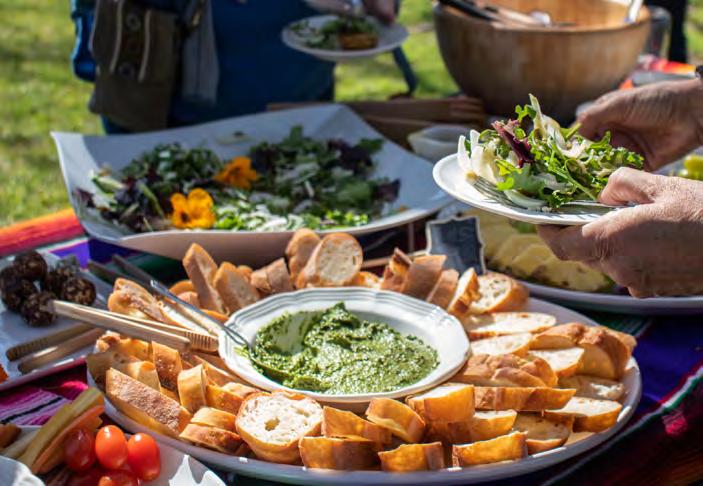 BY LINDSAY A. SMITH • PHOTOGRAPHY BY MIA BALLESTEROS
BY LINDSAY A. SMITH • PHOTOGRAPHY BY MIA BALLESTEROS
It all started over a decade ago at Olivewood Gardens & Learning Center, a place where education, heritage, and a love of learning combine to spark interest in new generations. Dedicated to providing programs for the National City population, Olivewood works with volunteers to share their knowledge, kitchen, and educational garden with others. One of Olivewood’s most successful programs is Cooking for Salud. In National City where some of the highest rates of obesity and diabetes in San Diego County are occuring, Cooking for Salud introduces families to lifestyle practices that can prevent health issues before they start by changing the foods they eat. Participants learn how to cook with natural ingredients and are introduced to traditional regional cuisine and cooking methods. The program takes basic concepts, like limiting processed foods and introducing nutrient-dense meals, and turns them into a way of life that is changing a community.
After completing the Cooking for Salud program, graduates may join the Kitchenistas, a volunteer program to continue sharing their food journey with the community. Kitchenistas are dedicated to using simple approaches to food while elevating traditional recipes at the same time. And what’s even more impressive? Most of their recipes are wholly plant-based. They aspire to create a community full of healthy cooks who embrace their heritage and are dedicated to preserving the recipes of the past.
The Kitchenista initiative has become so popular throughout the community that they have expanded to catering. Imagine learning to cook tortillas from scratch and then turning around to serve those tortillas to others. The delicious dishes they cook up for an event are things anyone can do to create a Kitchenista-worthy gathering of their own—and they’ve shared some of their best menu planning tips so we can all party like a Kitchenista. D
46 ediblesandiego.com
TAKEAWAY |
»olivewoodgardens.org
Love this story? Look for more original recipes inspired by the Kitchenistas to go with it on ediblesandiego.com this fall.
Created by Selina Pino
½ head of cauliflower, broken into florets (about 2 cups)
1 jalapeño or serrano chile, seeded and minced
1 tomato, diced
1 red onion, diced

Cilantro, chopped, to taste
3-4 limes, juiced
1 clove garlic, minced
Salt and pepper to taste
¼ teaspoon cumin
Tostadas or chips, to serve
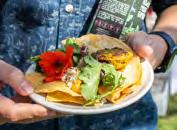
Blanch cauliflower until al dente, 4 to 5 minutes. Chop florets into small pieces (smaller than a dime) and place in a large bowl. Add all ingredients to the diced cauliflower and mix well. This tastes best when marinated for at least two hours.
Serve with your favorite tostadas or chips.
Variety is key, with lots of food options using different textures, colors, and ingredients. Try to have both hot and cold offerings. Every eater has different preferences and your goal as a host is to meet each one.


Set up a drink station with both nonalcoholic and alcoholic beverages, like wine, beer, kombucha, hot tea, or coffee, and have a variety of choices in each.


Always have water easily accessible.
Having a premium selection of dips with crudité or charcuterie to offer is a solid strategy to give guests something to remember. It doesn’t have to be a board spread, just a collection of different finger foods. Focus on a few dips, spreads, or sauces—if you are only going to make a few homemade items, this is where to spend your time. Assembling an assortment of dippers makes it easy to ensure that there is something for everyone and for every taste. Put it all together and you have the perfect starter, side, and in-between for grazing.
Set the mood through decor. Choose tablecloths, flowers, and decorations that reflect the food you are serving and visually complement the ingredients. Select serving platters to fit each dish and the overall theme. Let everything work together to tell a story—the story of your food.
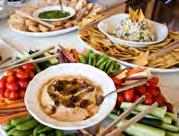
Looking for customers that care about the same things you do?
OUR READERS AT A GLANCE
68% travel 83% interested in solar technology
71% interested in electric or hybrid vehicles
93% read our ads
93% cook for pleasure
84% like to dine out, most once a week
ADVERTISERS GUIDE | WITH APPRECIATION FOR THESE BUSINESSES
Thank you to our advertisers. Readers, please patronize these supporters of our vibrant local food system and Edible San Diego’s editorial mission.
A.R. VALENTIEN
CATALINA OFFSHORE PRODUCTS
CHUPAROSA WINERY
COLLIN’S AND COUPE
DA-LE RANCH
DOCKSIDE 1953
DRISCOLL’S
EPIKWORK

78% have contacted, visited, or purchased from our advertisers
Scan the QR code to find out more about great rates for print and digital advertising
88% are more likely to shop at our advertisers' businesses
70% garden 1 5
ANSWER KEY: FALL WORD PLAY (PAGE 24)

FALLBROOK CHAMBER OF COMMERCE
GOLDEN DOOR COUNTRY STORE
THE GRAND TEA ROOM
GRANGETTO’S FARM AND GARDEN
GRILLWORKS
IDYLLWILD ARTS NATIVE AMERICAN CENTER
KVARØY
LEUCADIA FARMERS’ MARKET
LUCKY BOLT
MAINSTREET OCEANSIDE FARMERS’ MARKET
MATT YUNKER, REALTOR
MAYA MOON
MERMAID VALLEY VINEYARD
MICHAEL SHESS - NORTHWESTERN MUTUAL
MILLPORT
MISSION VALLEY FARMERS’ MARKET
MITCH’S SEAFOOD
OCEANA
OCEAN BEACH PEOPLE’S ORGANIC FOOD MARKET
PERENNIAL PASTURES
RAMONA RANCH WINERY
RINCON RESERVATION ROAD BREWERY
RIPOL EFFECT
ROSE’S TASTING ROOM
SAFARI COFFEE
SAGE HILL RANCH GARDENS
SAN DIEGO COUNTY VINTNERS ASSOCIATION
SAN DIEGO FISHERMEN’S WORKING GROUP
SAN DIEGO FOOD SYSTEM ALLIANCE
SAN DIEGO RESTAURANT WEEK
SCENIC VALLEY RANCH VINEYARDS
SOLARE
SPECIALITY PRODUCE
SPICE BREEZE
STATE STREET FARMERS’ MARKET - CARLSBAD
TETON WATERS RANCH
WHITE ROSE AQUA CREMATION
WOOF ‘N ROSE WINERY
Show off your business values and advertise with Edible San Diego.

48 ediblesandiego.com
Y E A R A N N I V E R S A R Y
Breathtaking Views, Uniquely California Cuisine
Now Open for Breakfast, Lunch, & Dinner

(858) 777-6635
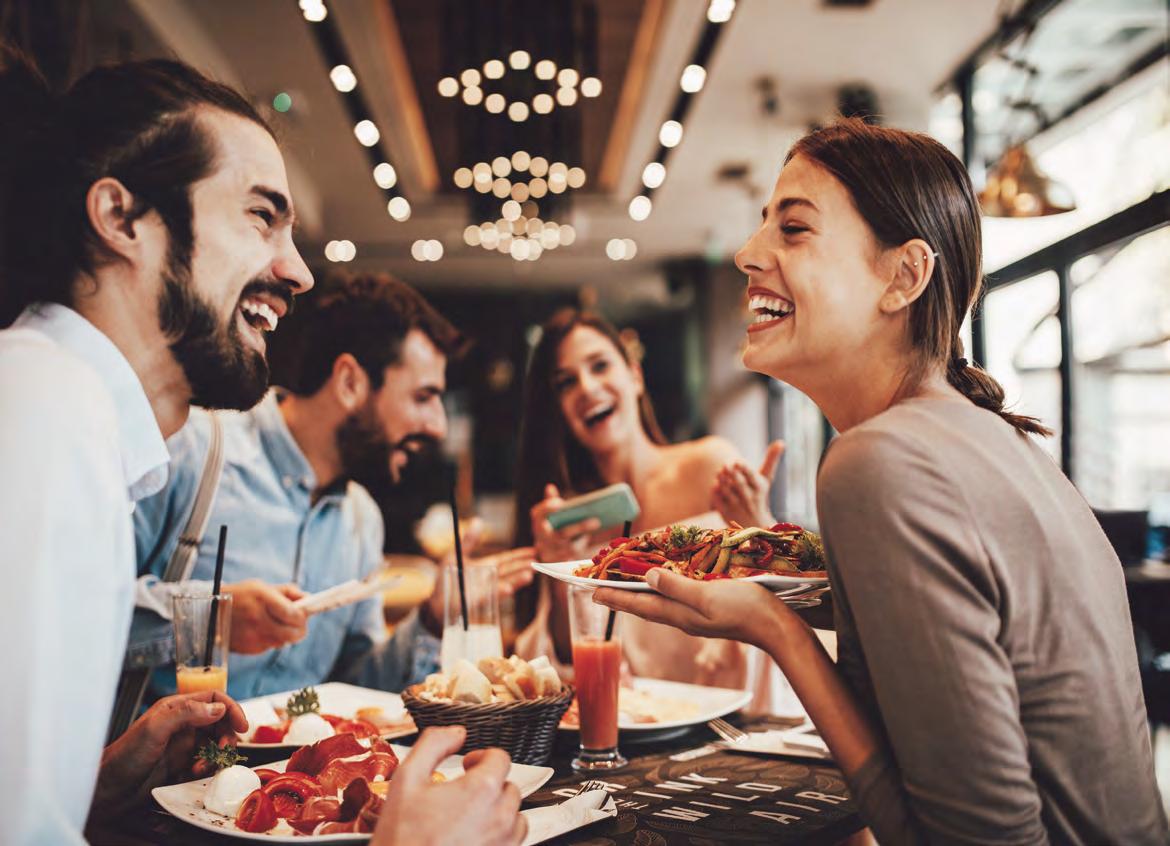
SEPT 24 - OCT 1 Presented by California Restaurant Association PRIX FIXE MENUS STARTING AT $20 Celebrate San Diego Dining Sept 24 - Oct 1 with over 100+ Participating Restaurants from Oceanside to Chula Vista SANDIEGORESTAURANTWEEK.COM











 PHOTO BY LAUREN DI MATTEO FOR EDIBLE SAN DIEGO
PHOTO BY LAUREN DI MATTEO FOR EDIBLE SAN DIEGO


















 Submitted by Thi Vo
Submitted by Thi Vo









































































































































































 BY LINDSAY A. SMITH • PHOTOGRAPHY BY MIA BALLESTEROS
BY LINDSAY A. SMITH • PHOTOGRAPHY BY MIA BALLESTEROS











